Getac Technology 8265NG WLAN module User Manual User Manaul
Getac Technology Corporation WLAN module User Manaul
Contents
- 1. User Manual
- 2. User Manual Host
- 3. User Manaul
User Manaul

Rugged Mobile Computing Solutions
X500
USER MANUAL

August 2017
TRADEMARKS
The Bluetooth® word mark and logos are registered trademarks owned by Bluetooth
SIG, Inc.
All brand and product names are trademarks or registered trademarks of their
respective companies.

i
Table of Contents
Chapter 1 Getting Started .......................................................................... 1
Getting the Computer Running ........................................... 2
Unpacking .................................................................. 2
Using the Tether (Optional) ......................................... 3
Connecting to AC Power ............................................... 4
Turning On and Off the Computer .................................. 5
Taking a Look at the Computer ......................................... 7
Front Components ........................................................ 7
Rear Components ........................................................ 8
Right-Side Components ................................................. 9
Left-Side Components .................................................. 10
Top-open Components ................................................. 11
Bottom Components ..................................................... 13
Chapter 2 Operating Your Computer ...................................................... 15
Using the Keyboard ........................................................ 16
Typewriter Keys .......................................................... 16
Cursor-Control Keys .................................................... 16
Numeric Keypad ......................................................... 17
Function Keys ............................................................ 18
Fn Key ..................................................................... 18
Hot Keys .................................................................. 18
Windows Keys ........................................................... 20
Using the Touchpad ........................................................ 21
Configuring the Touchpad ............................................ 22
Using the Touchscreen (Optional) ................................... 23

ii
Using Multi-touch Gestures (Optional) .......................... 24
Using the Quick Buttons ................................................. 26
Configuring the Quick Buttons ...................................... 27
Using the DVD Drive ..................................................... 28
Inserting and Removing a Disc..................................... 29
Using Network and Wireless Connections ............................ 31
Using the LAN ........................................................... 31
Using the WLAN ....................................................... 32
Using the Bluetooth Feature ......................................... 33
Using the WWAN Feature (Optional) ........................... 34
Using the Fingerprint Scanner (Optional) .......................... 36
Chapter 3 Managing Power ...................................................................... 38
AC Adapter .................................................................. 39
Battery Pack ................................................................ 40
Charging the Battery Pack ........................................... 40
Initializing the Battery Pack ........................................... 41
Checking the Battery Level ........................................... 41
Battery Low Signals and Actions ................................... 42
Replacing the Battery Pack .......................................... 43
Power-Saving Tips ........................................................ 44
Chapter 4 Expanding Your Computer ..................................................... 45
Connecting Peripheral Devices .......................................... 46
Connecting Display Monitor .......................................... 46
Connecting a Serial Device .......................................... 47
Connecting a USB Device ........................................... 47
Connecting an Audio Device ........................................ 48
Using Storage and Expansion Cards ................................. 49
Using Smart Cards .................................................... 49
Using PC Cards ........................................................ 50
Using ExpressCards ..................................................... 51
Using Storage Cards .................................................. 52
Changing or Replacing ................................................... 53
Replacing the Hard Disk Drive ..................................... 53
Installing a Secondary Battery Pack or Hard Disk Drive .... 53
System Memory Upgrade ............................................. 54

iii
Chapter 5 Using BIOS Setup .................................................................... 56
When and How to Use .................................................. 57
Menu Descriptions ......................................................... 58
Information Menu ....................................................... 58
Main Menu ............................................................... 58
Advanced Menu ......................................................... 59
Security Menu ........................................................... 60
Boot Menu ................................................................ 61
Exit Menu ................................................................. 61
Chapter 6 Using Getac Software ............................................................. 63
G-Manager .................................................................. 64
Chapter 7 Care and Maintenance ............................................................ 66
Protecting the Computer .................................................. 67
Using an Anti-Virus Strategy ....................................... 67
Using the Cable Lock ................................................. 67
Taking Care of the Computer .......................................... 69
Location Guidelines ..................................................... 69
General Guidelines ..................................................... 69
Cleaning Guidelines .................................................... 70
Battery Pack Guidelines .............................................. 70
Touchscreen Guidelines ............................................... 72
When Traveling ............................................................. 73
Chapter 8 Troubleshooting ...................................................................... 74
Preliminary Checklist ....................................................... 75
Solving Common Problems .............................................. 76
Battery Problems ........................................................ 76
Bluetooth Problems ..................................................... 76
Display Problems ....................................................... 77
DVD Drive Problems .................................................. 77
Hardware Device Problems .......................................... 78
Hard Disk Drive Problems ........................................... 78
Keyboard and Touchpad Problems ................................. 79
LAN Problems ........................................................... 79
Power Management Problems ....................................... 80

iv
Software Problems ..................................................... 80
Sound Problems ........................................................ 80
Startup Problems ........................................................ 81
WLAN Problems ......................................................... 81
Other Problems ......................................................... 83
Resetting the Computer .................................................. 84
System Restore, Recovery, or Reset ................................. 85
Using the Driver Disc .................................................... 86
Appendix A Specifications .......................................................................... 87
Appendix B Regulatory Information ........................................................... 89
On the Use of the System ............................................. 90
Class B Regulations ................................................... 90
Safety Notices ............................................................ 91
On the Use of the RF Device ........................................ 94
USA and Canada Safety Requirements and Notices.......... 94
European Union CE Marking and Compliance Notices ....... 96
User Notification of Take-back Service ............................. 100
ENERGY STAR 6.1 ...................................................... 101
Battery Recycling .......................................................... 103

1
Chapter 1
Chapter 1 Getting Started
Congratulations on purchasing this rugged computer.
This chapter first tells you step by step how to get the computer up and running.
Then, you will find a section briefly introducing the external components of the
computer.
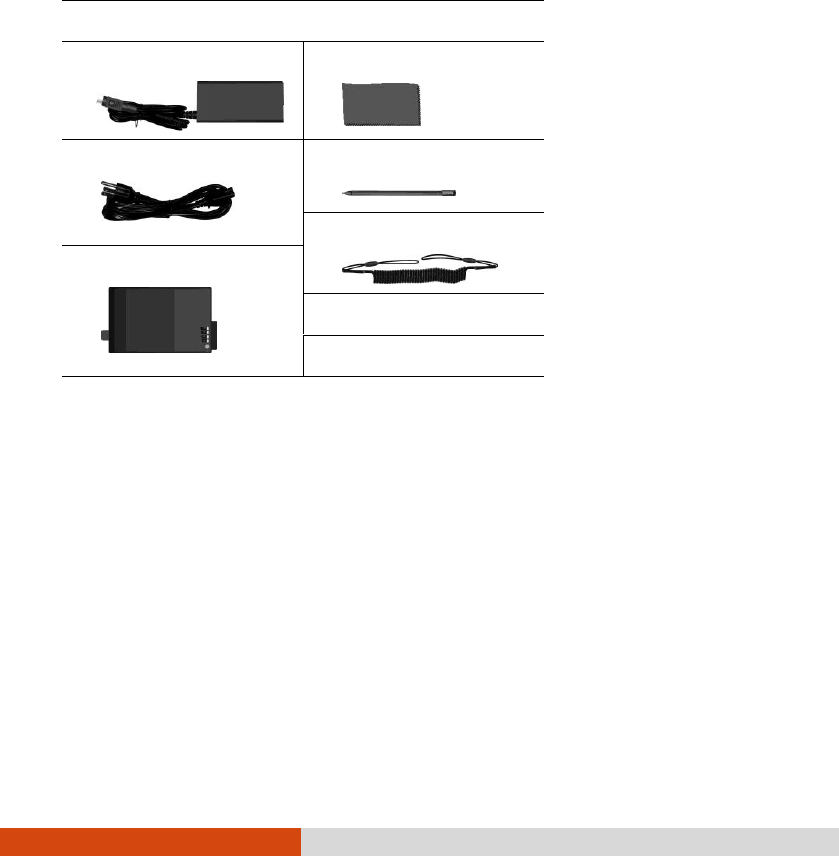
2
Getting the Computer Running
Unpacking
NOTE: This packing list applies to standard models. Select
models may have different items.
After unpacking the shipping carton, you should find these standard items:
X500 notebook computer
AC adapter
Screen cleaning cloth
AC power cord
Stylus*
Tether*
Battery pack
Driver disc*
Document(s)
* Optional
Inspect all the items. If any item is damaged or missing, notify your dealer
immediately.
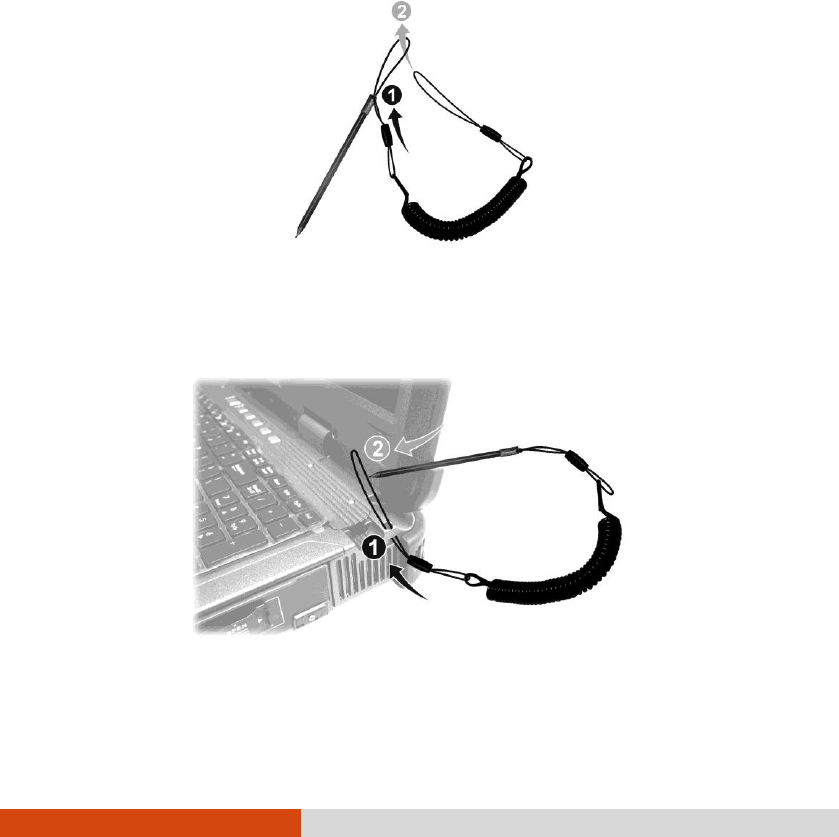
3
Using the Tether (Optional)
A tether is available for attaching the stylus to your computer.
1. Insert one of the tether’s loop ends through the hole of the stylus (as indicated
by below). Then, insert the other end through the first loop (as indicated
by below) and pull it tight.
2. Insert the other loop end to the strap holder on comp uter (as indicated by
below). Then, insert the stylus end through the loop (as indicated by
below) and pull it tight.
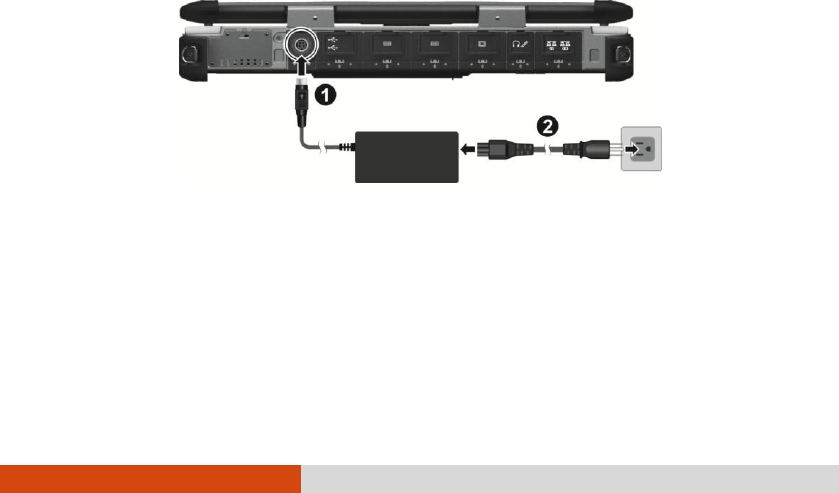
4
Connecting to AC Power
CAUTION: Use only the AC adapter included with your computer.
Using other AC adapters may damage the computer.
NOTE:
The battery pack is shipped to you in power saving mode that
protects it from charging/discharging. It will get out of
the mode to be ready for use when you install the battery
pack and connect AC power to the computer for the very first
time.
When the AC adapter is connected, it also charges the battery
pack. For information on using battery power, see Chapter
3.
You must use AC power when starting up the computer for the very first time.
1. Plug the DC cord of the AC adapter to the power connector of the computer
().
2. Plug the female end of the AC power cord to the AC adapter and the male
end to an electrical outlet ().
3. Power is being supplied from the electrical outlet to the AC adapter and onto
your computer. Now, you are ready to turn on the computer.
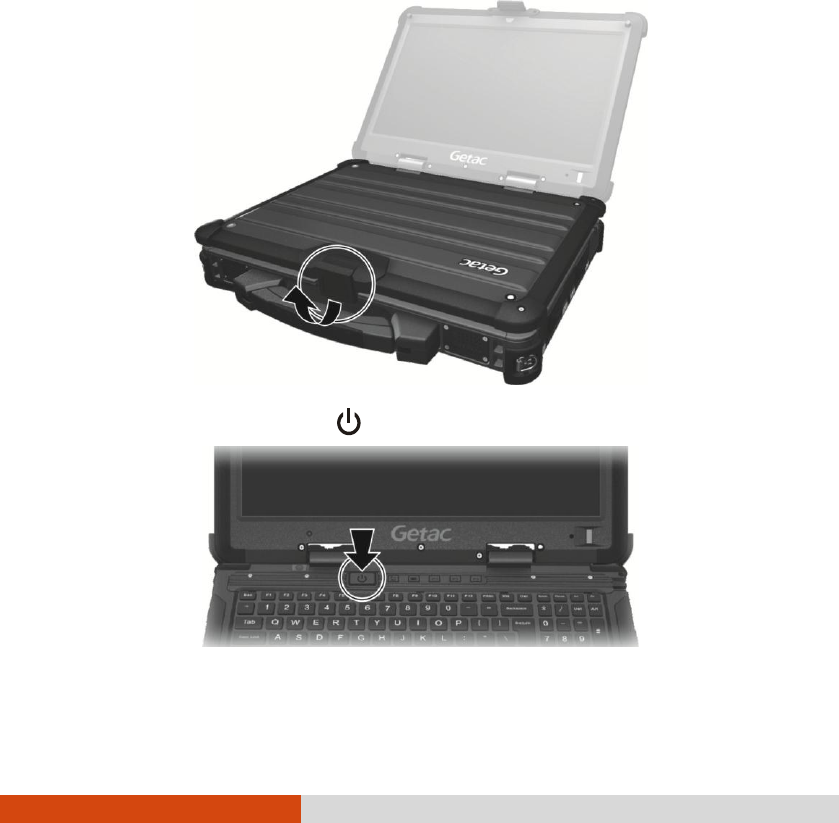
5
Turning On and Off the Computer
Turning On
1. Open the top cover by pulling the cover latch and lifting up the cover. You
can tilt the cover forward or backward for optimal viewing clarity.
2. Press the power button ( ). The Windows operating system should start.
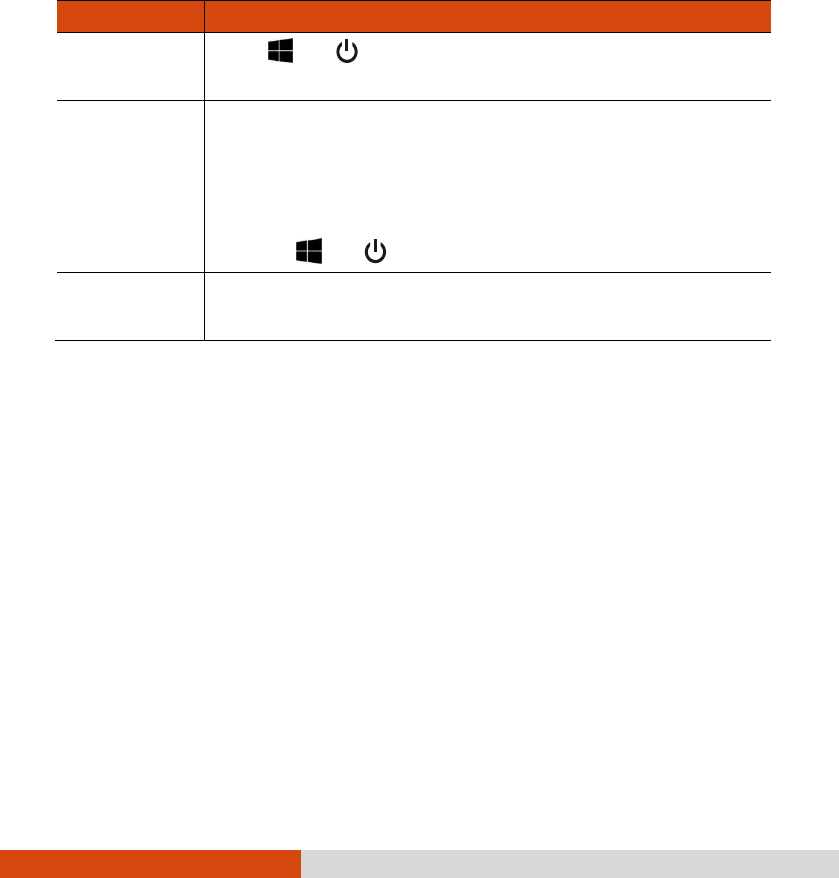
6
Turning Off
When you finish a working session, you can stop the system by turning off the
power or leaving it in Sleep or Hibernation mode:
To...
Do this...
Power off
(Shutdown)
Click Power Shut down.
Sleep
Use one of these methods:
Press the power button.*
Close the top cover.*
Press Fn + F10.*
Click Power Sleep.
Hibernate
By default, this option is not shown in the Start menu. If you
want to use the feature, set up accordingly in Windows settings.
* “Sleep” is the default result of the action. You can change what the action
does through Windows settings.
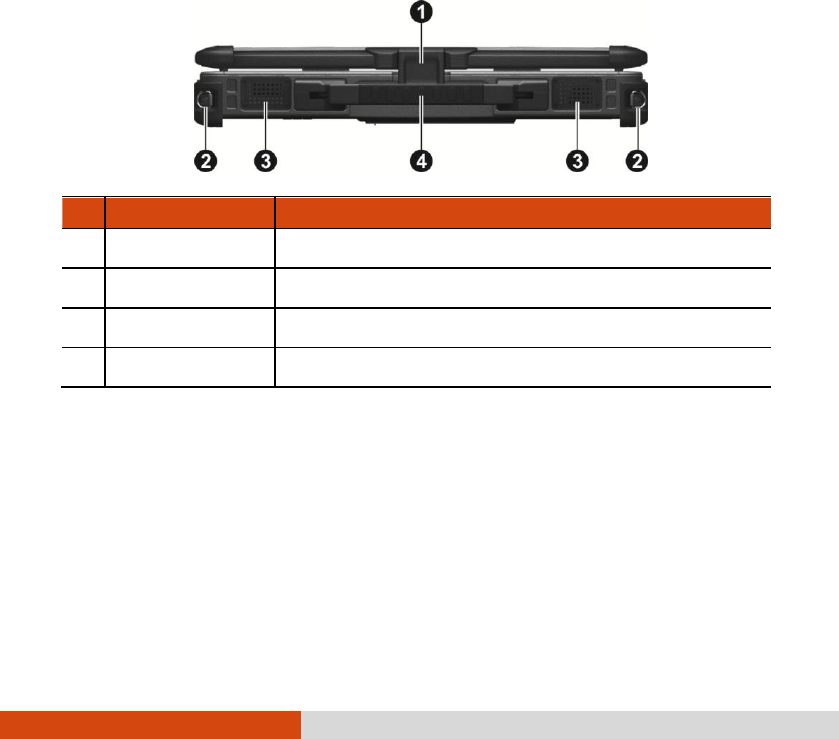
7
Taking a Look at the Computer
NOTE: Depending on the model you purchased, the appearance of
your computer may not be exactly the same as those shown in this
manual.
CAUTION: You need to open the protective covers to access the
connectors or devices inside. When not accessing a connector
or device, make sure to close the cover completely for water-,
dust-, and fire-proof integrity of your computer. (Engage the
locking mechanism if existing.)
Front Components
Ref
Component
Description
Top cover latch
Locks the top cover.
Strap holder
Two buckles hold the shoulder strap.
Stereo speaker
Sends out sound and voice from the computer.
Handle
Provides a convenient way to carry the computer.
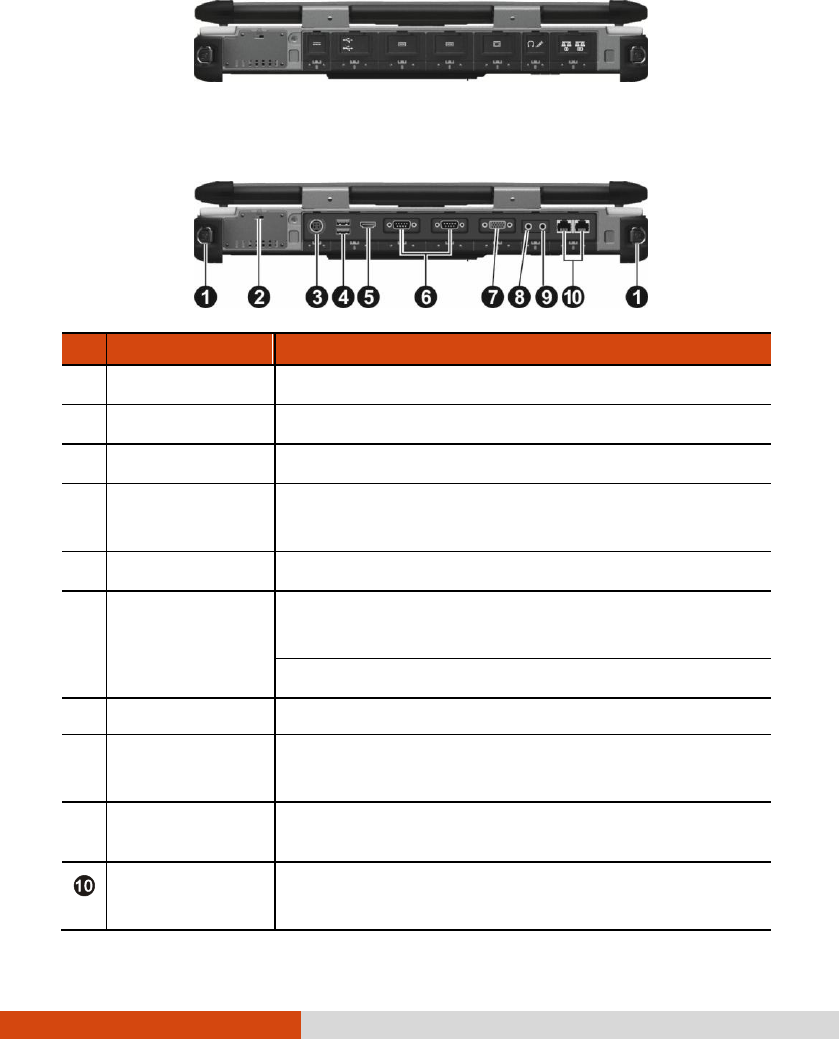
8
Rear Components
To access a connector, open its protective cover by pushing down the tab. When
closing, push the tab upward so it clicks into the locked position.
Ref
Component
Description
Strap holder
Two buckles hold the shoulder strap.
Kensington lock
Locks the computer to a stationary object for security.
Power connector
Connects the AC adapter.
USB 3.0 port
Connects a USB device, such as a USB flash disk,
printer, digital camera, joystick, and more.
HDMI connector
Connects a HDMI monitor or TV set.
Serial connector
Connects a serial device. The left one is COM1 and the
right one is COM2.
Can be configured as RS232 or RS422.
VGA connector
Connects an external display monitor.
Audio output
connector
Connects a set of headphones or external speakers with
amplifier.
Microphone
connector
Connects an external microphone.
RJ-45 connector
Connects the LAN cable. The left one is LAN1 and the
right one is LAN2.
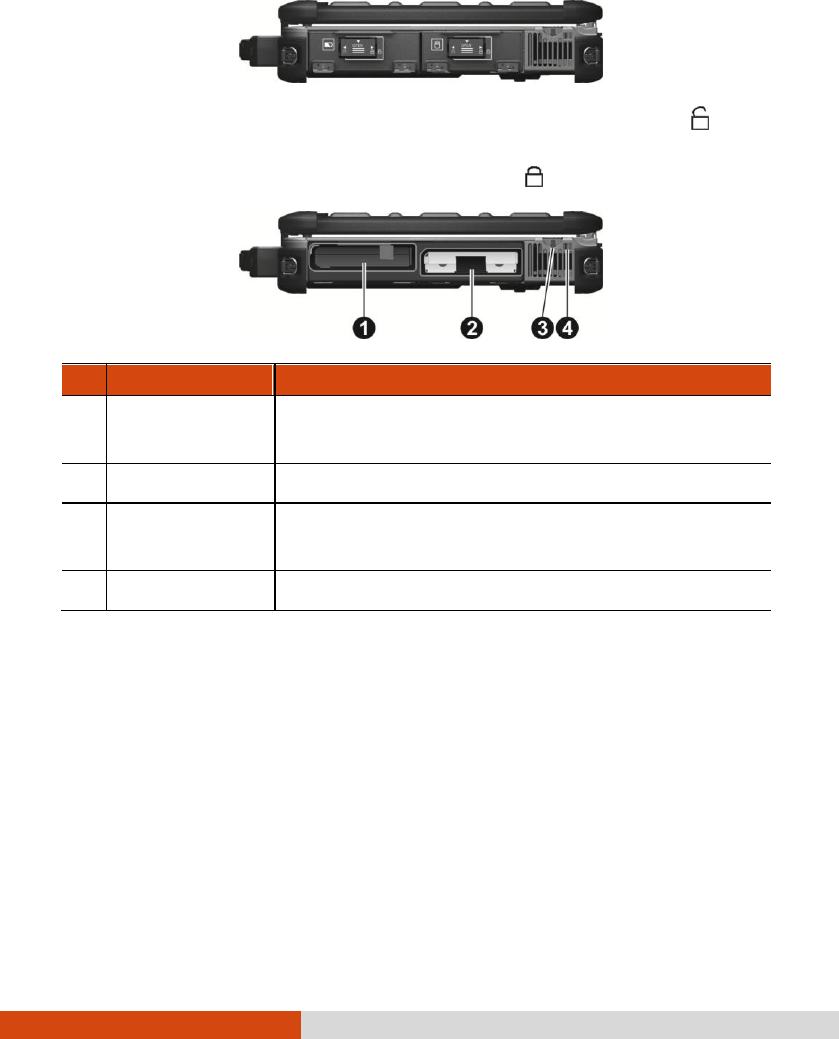
9
Right-Side Components
To access a device bay, slide the latch toward the right to unlock ( ) and
then push down the latch to release the cover. When closing, engage the latch
and then slide the latch toward the left to lock ( ).
Ref
Component
Description
Battery pack
Supplies power to your computer when external power
is not connected.
Hard disk drive
Inside is the hard disk drive.
Stylus (optional)
Serves as the input device by tapping on the touchscreen
to make selections and enter information.
Tether hole
Stylus tethered to this hole.
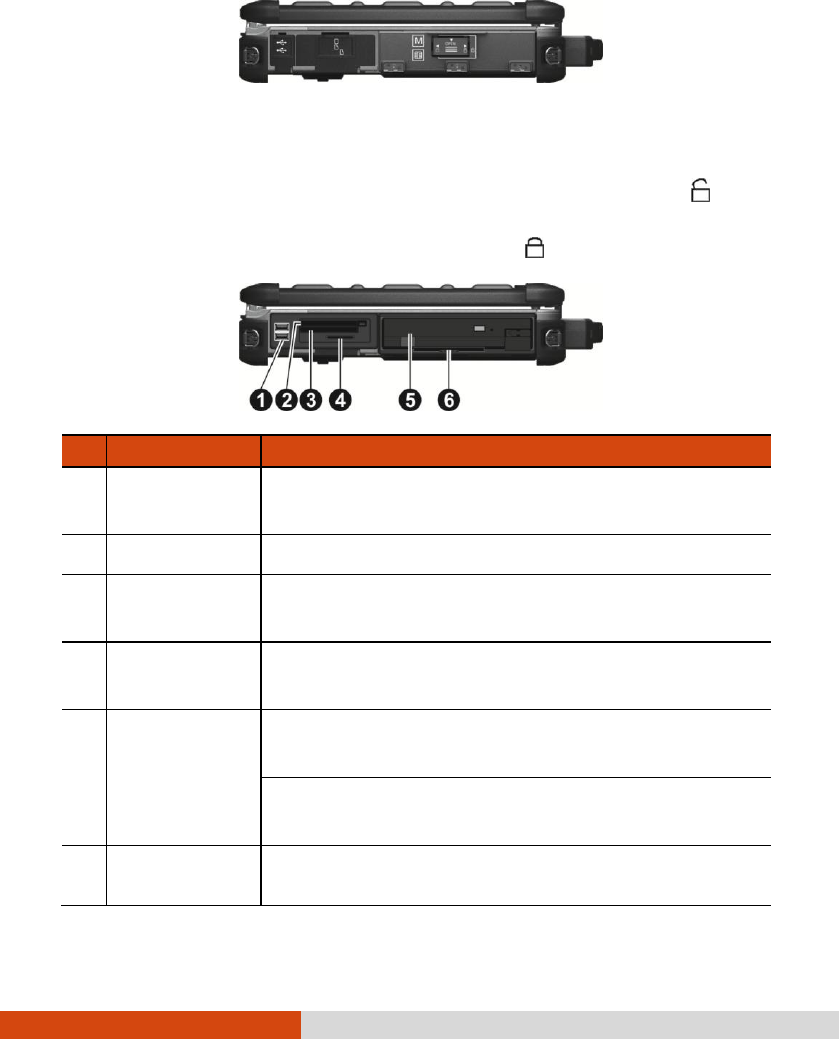
10
Left-Side Components
To access a connector, open its protective cover by pushing down the tab. When
closing, push the tab upward so it clicks into the locked position.
To access a device bay, slide the latch toward the right to unlock ( ) and
then push down the latch to release the cover. When closing, engage the latch
and then slide the latch toward the left to lock ( ).
Ref
Component
Description
USB 3.0 port
Connects a USB device, such as a USB flash disk, printer,
digital camera, joystick, and more. There are two ports.
PCMCIA slot
Accepts a PC card for additional functions.
ExpressCard slot
Accepts an ExpressCard/34 or ExpressCard/54 for
additional functions.
SD card reader
Accepts a Secure Digital (SD) card for removable storage
media.
Super multi
drive
Accepts a compact disc for installing or loading software,
accessing data, and playing music/video.
Can be replaced by a secondary hard disk drive or battery
pack (purchased separately).
Smart card
reader
Accepts a smart card for additional security feature.
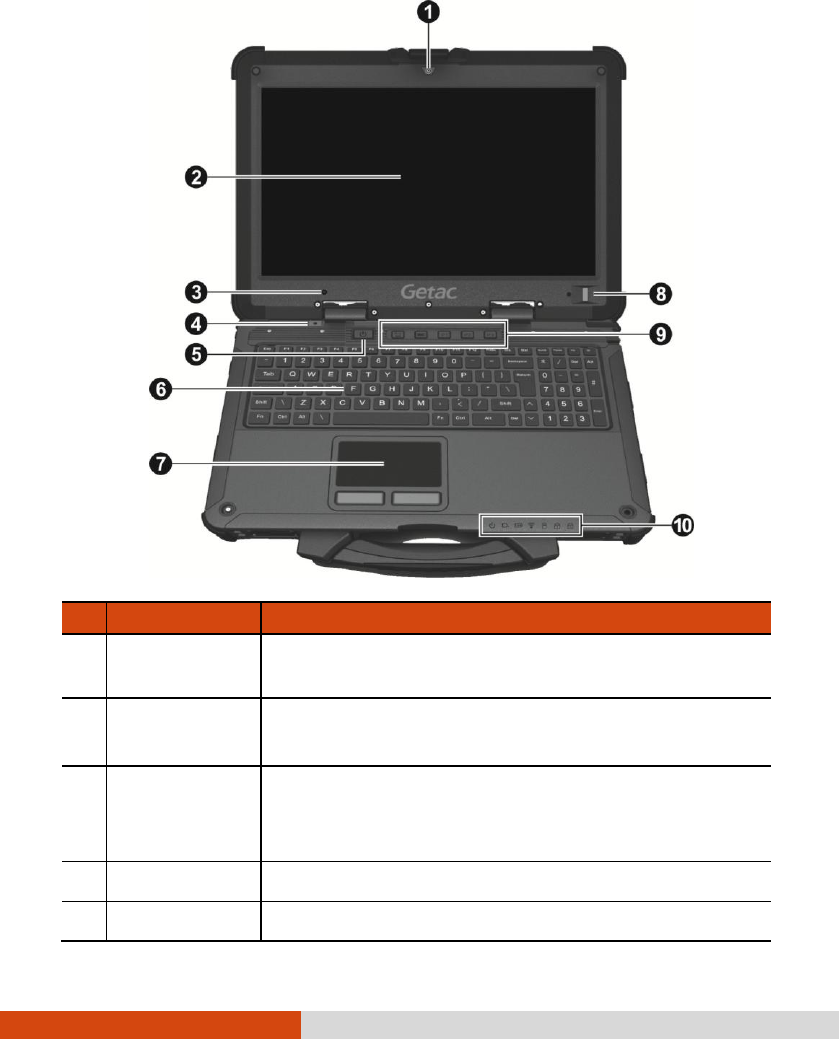
11
Top-open Components
Ref
Component
Description
Camera lens
(optional)
Allows you to use the camera function.
LCD screen
Displays the output of the computer. May include the
optional touchscreen feature.
Light sensor
Detects the surrounding lighting condition for automatic
adjustment of the LCD brightness and optional keyboard
backlight.
Microphone
Receives sound and voice for the computer.
Power button
Turns the power on or off (Sleep mode by default).
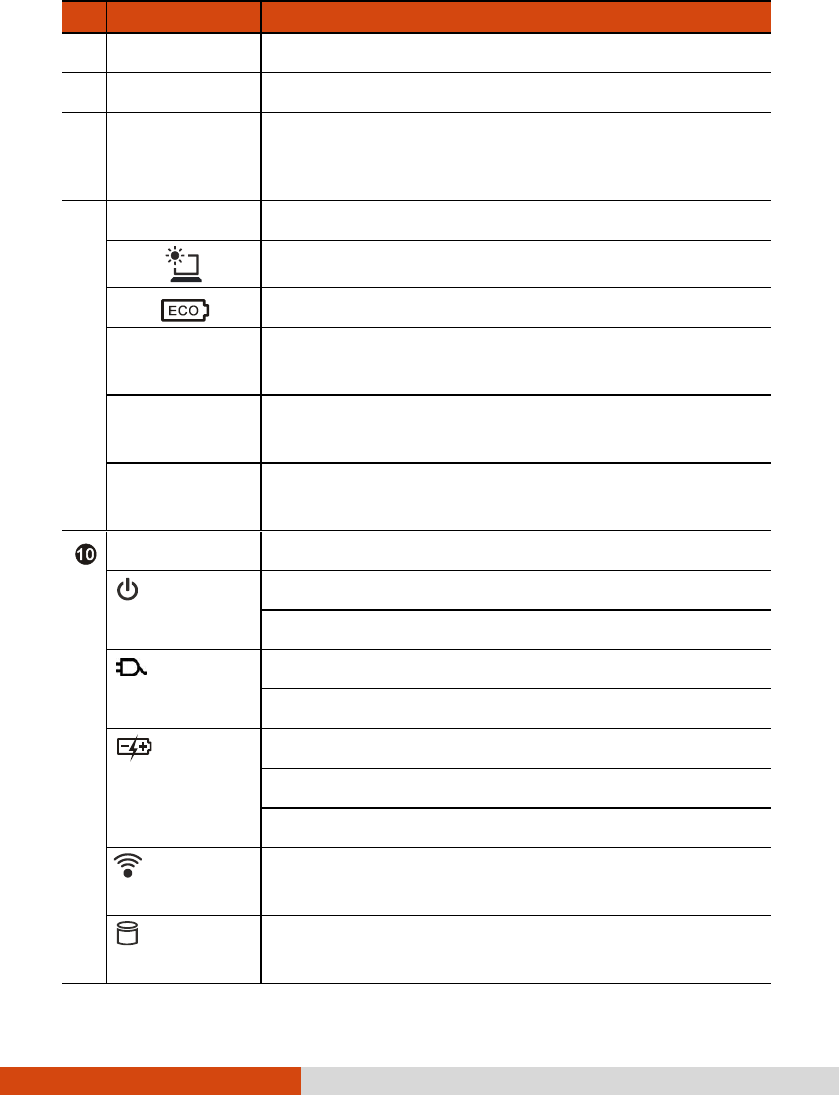
12
Ref
Component
Description
Keyboard
Serves as the data input device of the computer.
Touchpad
Serves as the pointing device of the computer.
Fingerprint
scanner
(optional)
Serves as the fingerprint verification, preventing
unauthorized access to your computer.
Quick buttons
Toggles the sunlight-readable mode on or off.
Switches the ECO mode to the next choice
P1
Toggles Blackout mode on or off. (The function can be
redefined.)
P2
Toggles the touchpad off or on. (The function can be
redefined.)
P3
Toggles the light sensor on or off. (The function can be
redefined.)
Indicators
Power
Lights green when the computer is on.
Blinks green when the computer is in Sleep mode.
AC power
Lights green when the computer is operating with AC power.
Lights red when the optional hard disk drive heater is on.
Battery
charge
Lights green when the battery is fully charged.
Lights amber when the battery is being charged.
Blinks red when the battery’s capacity is below 10 %.
RF
Lights green when the RF radio of any RF feature
(WLAN/Bluetooth/WWAN) is on.
Hard disk
drive
Blinks green when computer is reading / writing data to
the hard disk.
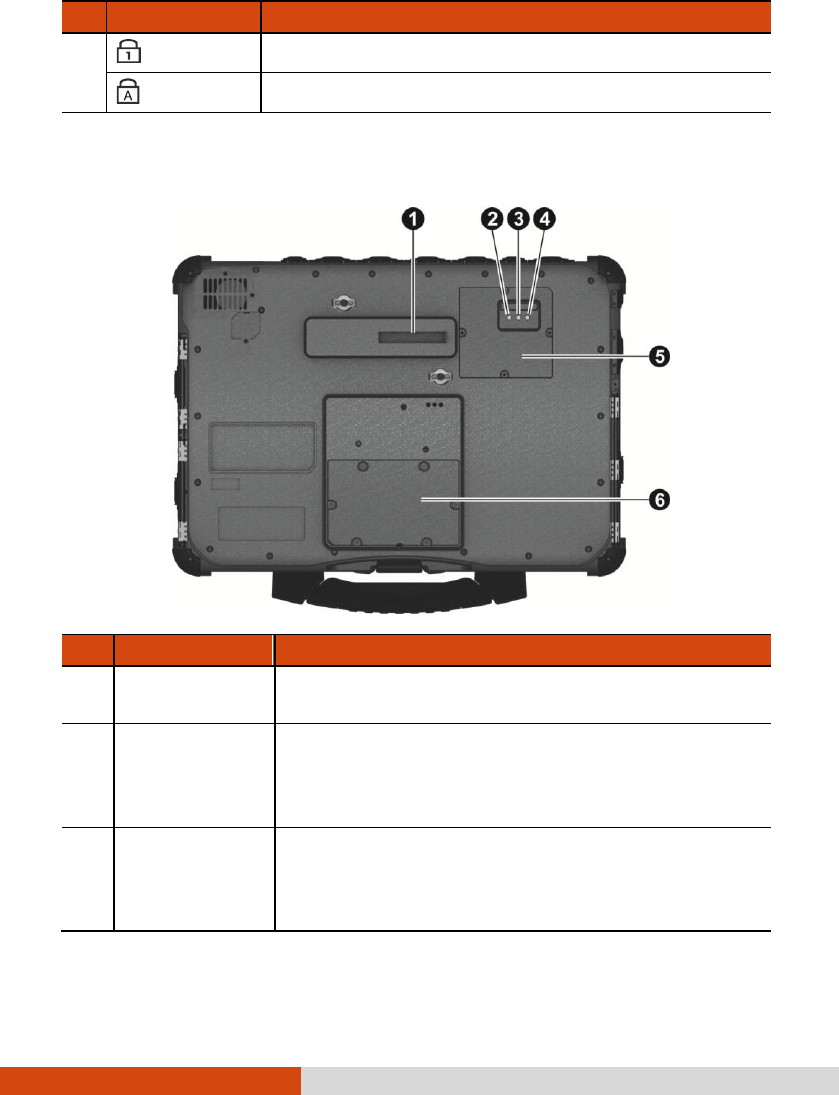
13
Ref
Component
Description
Num Lock
Lights green when Num Lock is on.
Caps Lock
Lights green when Caps Lock is on.
Bottom Components
Ref
Component
Description
Docking
connector
Connects to the Vehicle Dock (purchased separately).
WLAN antenna
pass-through
connector
(optional)
Connects the external antenna for WLAN connectivity.
NOTE: Must be connected via a docking
station.
GPS antenna
pass-through
connector
(optional)
Connects the external antenna for GPS signal reception.
NOTE: Must be connected via a docking
station.

14
WWAN antenna
pass-through
connector
(optional)
Connects the external antenna for WWAN connectivity.
NOTE: Must be connected via a docking
station.
SIM card slot
(optional)
Inside is the SIM card slot.
Memory slots
Inside are the memory slots for expanding the memory
size of your computer.

15
Chapter 2
Chapter 2 Operating Your Computer
This chapter provides information about the use of the computer.
If you are new to computers, reading this chapter will help you learn the operating
basics. If you are already a computer user, you may choose to read only the parts
containing information unique to your computer.
CAUTION:
Do not expose your skin to the computer when operating it
in a very hot or cold environment.
The computer can get uncomfortably warm when you use it in
high temperatures. As a safety precaution in such a
circumstance, do not place the computer on your lap or touch
it with your bare hands for extended periods of time.
Prolonged body contact can cause discomfort and potentially
a burn.

16
Using the Keyboard
Your keyboard has all the standard functions of a full-sized computer keyboard plus
an Fn key added for specific functions.
The standard functions of the keyboard can be further divided into four major
categories:
Typewriter keys
Cursor-control keys
Numeric keys
Function keys
Typewriter Keys
Typewriter keys are similar to the keys on a typewriter. Several keys are added
such as the Ctrl, Alt, Esc, and lock keys for special purposes.
The Control (Ctrl) / Alternate (Alt) key is normally used in combination with other
keys for program-specific functions. The Escape (Esc) key is usually used for
stopping a process. Examples are exiting a program and canceling a command.
The function depends on the program you are using.
Cursor-Control Keys
Cursor-control keys are generally used for moving and editing purposes.
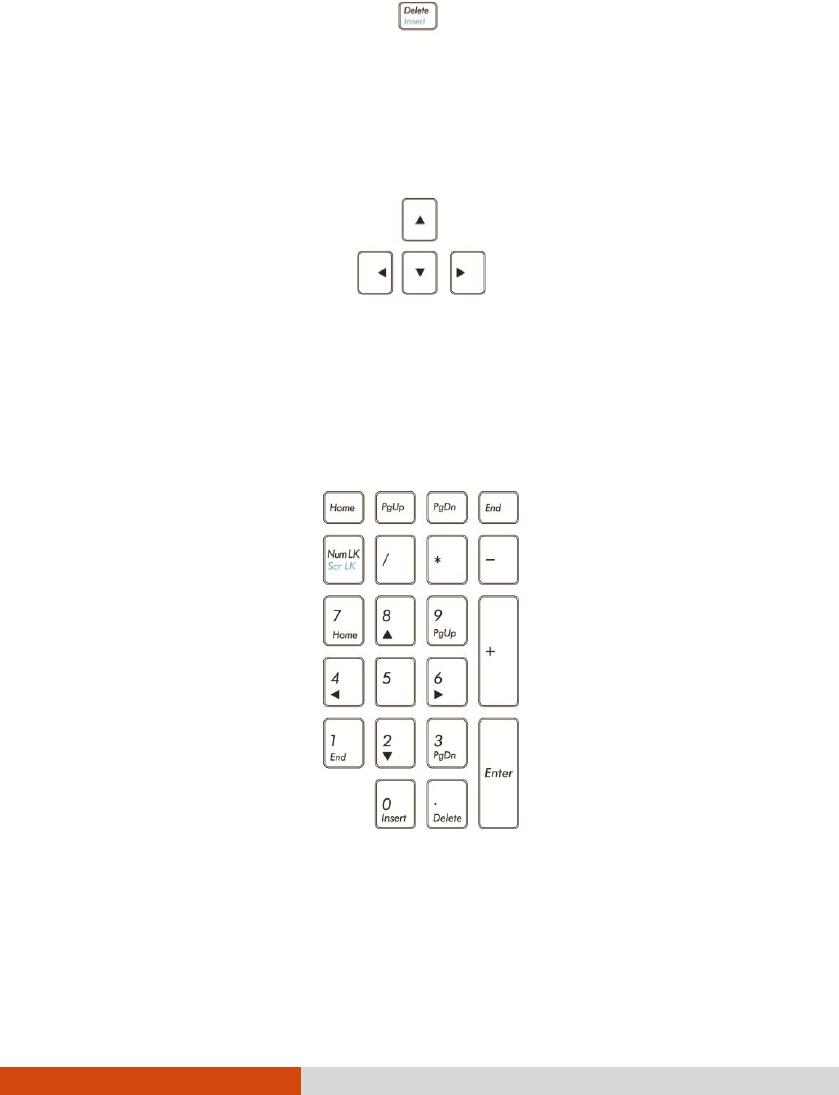
17
NOTE: The word “cursor” refers to the indicator on the screen
that lets you know exactly where on your screen anything you
type will appear. It can take the form of a vertical or
horizontal line, a block, or one of many other shapes.
Numeric Keypad
Numeric keys facilitate entering of numbers and calculations. When Num Lock is
on, the numeric keys are activated; meaning you can use these keys to enter
numerals.
When Num Lock is off, the keys serve as cursor-control keys.
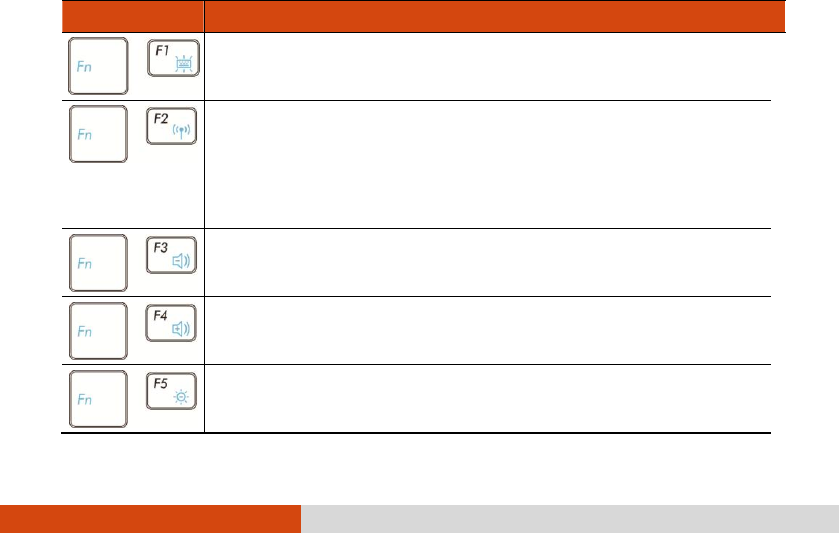
18
Function Keys
On the top row of the keys are the function keys: F1 to F12. Function keys are
multi-purpose keys that perform functions defined by individual programs.
Fn Key
The Fn key, at the lower left corner of the keyboard, is used with another key
to perform the alternative function of a key. To perform a desired function, first press
and hold Fn, then press the other key.
Hot Keys
Hot keys refer to a combination of keys that can be pressed any time to activate
special functions of the computer. Most hot keys operate in a cyclic way. Each
time a hot key combination is pressed, it shifts the corresponding function to the
other or next choice.
You can easily identify the hot keys with the icons imprinted on the keytop. The
hot keys are described next.
Key
Description
Switches the keyboard backlight on and off (option).
Switches the RF (radio frequency) radio on or off.
When off, all wireless modules (such as WLAN, Bluetooth, and
WWAN) cannot be used. When on, individual settings of the
module work.
Decreases the sound volume.
Increases the sound volume.
Increases the LCD brightness.
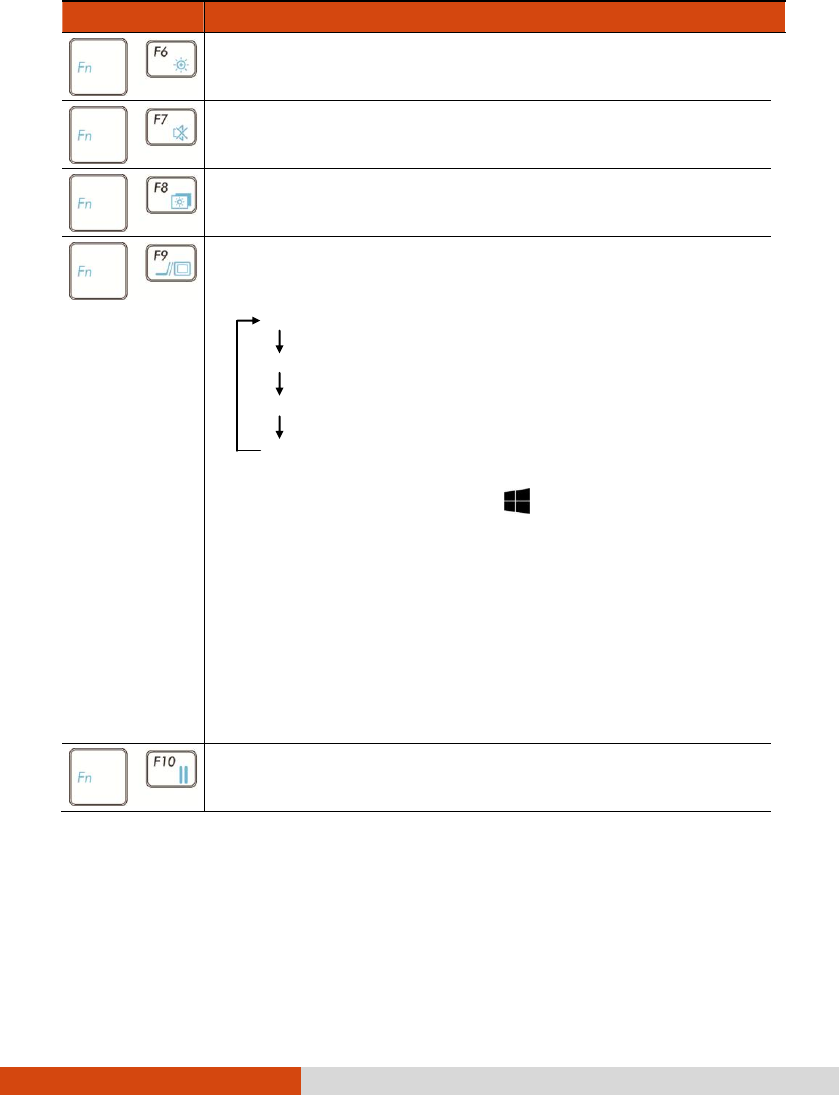
19
Key
Description
Decreases the LCD brightness.
Switches the system sound output off (mute) or on.
Switches the display off or on.
Switches the display output to the next choice if an external display
is connected. Choices are:
LCD only
LCD + External display (Duplicate)
LCD + External display (Extend)
External display only
The hot keys are equivalent to Windows logo key + P.
NOTE:
Display resolution remains unchanged when you
switch the display output using this hot key
combination.
This hot key combination does not function
during the playback of DVD or MPEG files by
certain applications.
This hot key combination does not function in
full screen DOS mode.
Serves as the sleep button that you can define with Windows’
Power Options.
NOTE:
If you have changed your system from the default ACPI mode
to APM mode, the hot keys Fn+F3, Fn+F4, and Fn+F10 will not
be supported.
The operating system might ignore the hot keys when busy with
tasks. Do not keep on pressing the hot keys under such
circumstance. Wait for a while before you try again.
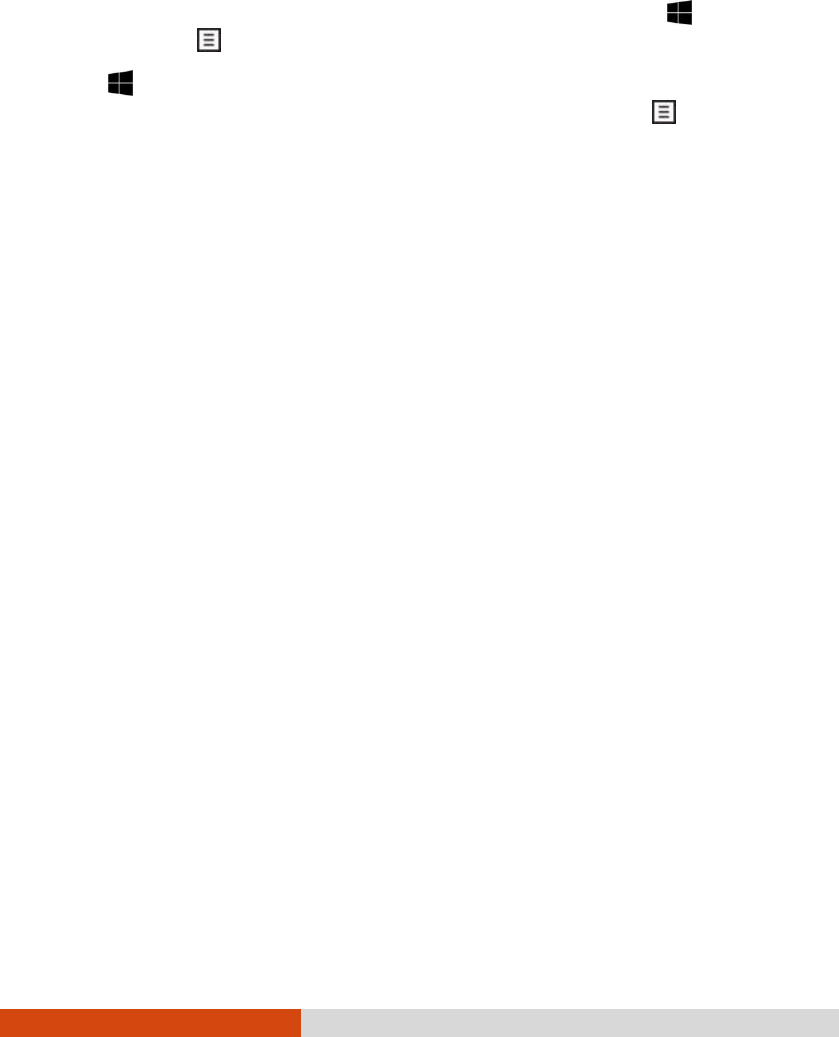
20
Windows Keys
The keyboard has two keys that perform Windows-specific functions: Windows
Logo key and Application key.
The Windows Logo key opens the Start menu and performs software-
specific functions when used in combination with other keys. The Application
key usually has the same effect as a right mouse click.
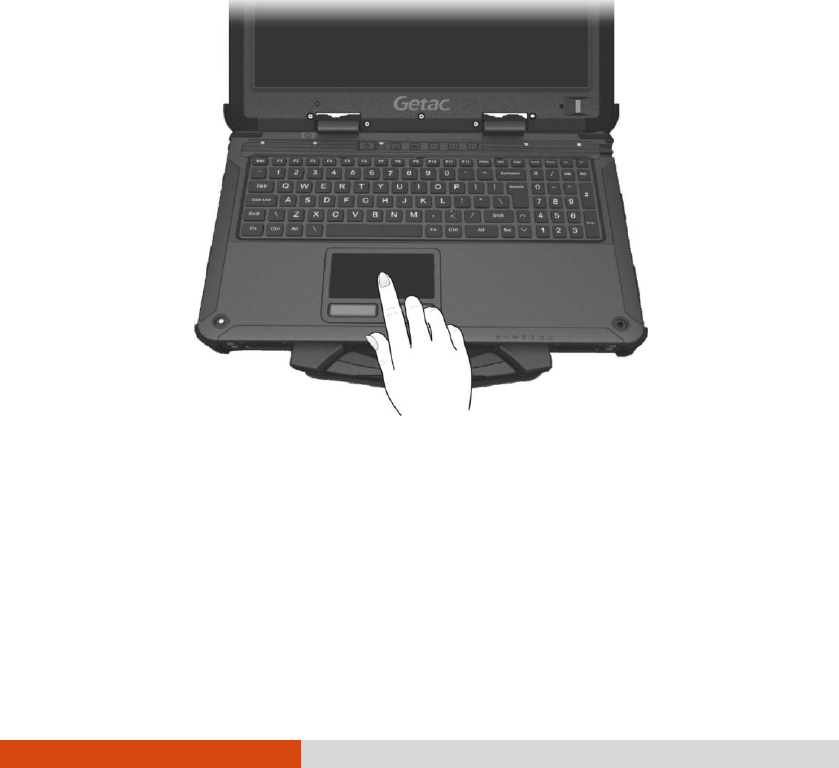
21
Using the Touchpad
CAUTION: Do not use a sharp object such as a pen on the touchpad.
Doing so may damage the touchpad surface.
NOTE: For optimal performance of the touchpad, keep your fingers
and the pads clean and dry. When tapping on the pad, tap lightly.
Do not use excessive force.
The touchpad is a pointing device that allows you to communicate with the computer
by controlling the location of the pointer on the screen and making selection with
the buttons.
The touchpad consists of a rectangular pad (work surface) and a left and right
buttons. To use the touchpad, place your forefinger or thumb on the pad. The
rectangular pad acts like a miniature duplicate of your display. As you slide your
fingertip across the pad, the pointer (also called cursor) on the screen moves
accordingly. When your finger reaches the edge of the pad, simply relocate yourself
by lifting the finger and placing it on the other side of the pad.
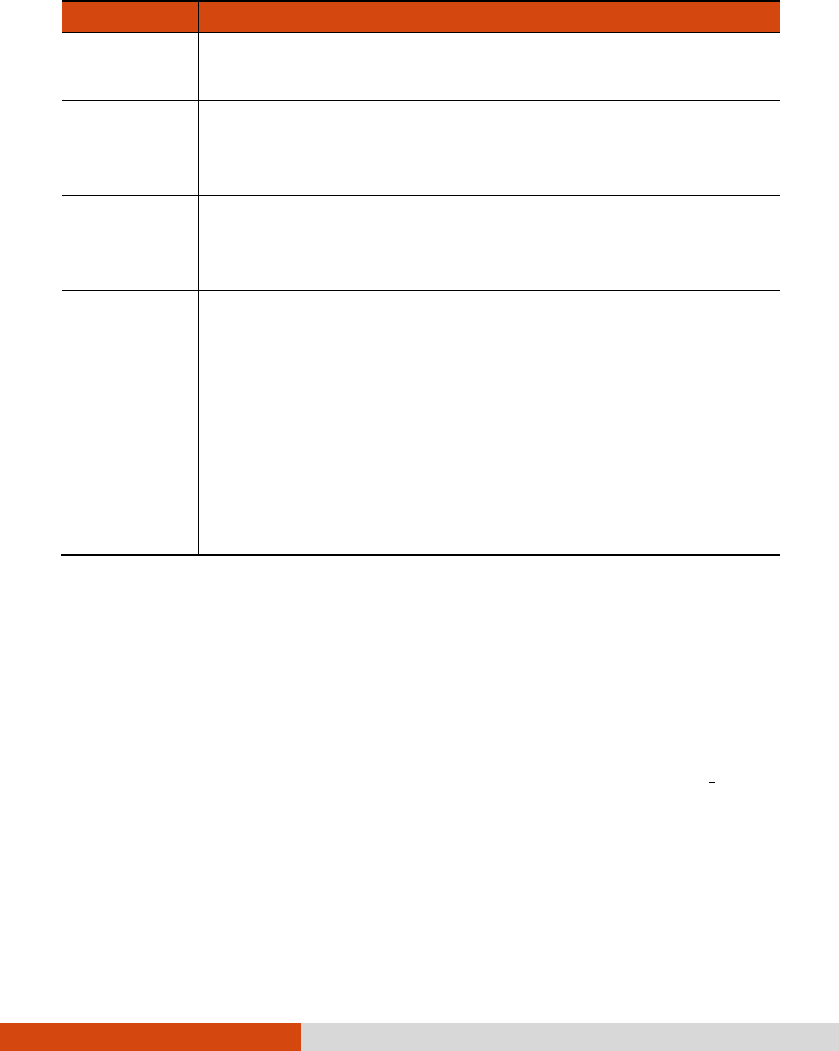
22
Here are some common terms that you should know when using the touchpad:
Term
Action
Point
Move your finger on the pad until the cursor points to the selection
on the screen.
Click
Press and release the left button.
–or–
Tap gently anywhere on the pad.
Double-click
Press and release the left button twice in quick succession.
–or–
Tap twice on the pad rapidly.
Drag and
drop
Press and hold the left button, then move your finger until you
reach your destination (drag). Finally, release the button (drop)
when you finish dragging your selection to the destination. The
object will drop into the new location.
–or–
Gently tap twice on the pad and on the second tap, keep your
finger in contact with the pad. Then, move your finger across the
pad to drag the selected object to your destination. When you lift
your finger from the pad, the selected object will drop into place.
Configuring the Touchpad
You may want to configure the touchpad to suit your needs. For example, if you
are a left-handed user, you can swap the two buttons so that you can use the
right button as the left button and vice versa. You can also change the size of
the on-screen pointer, the speed of the pointer, and so on.
To configure the touchpad, go to Settings Devices Mouse & touchpad.
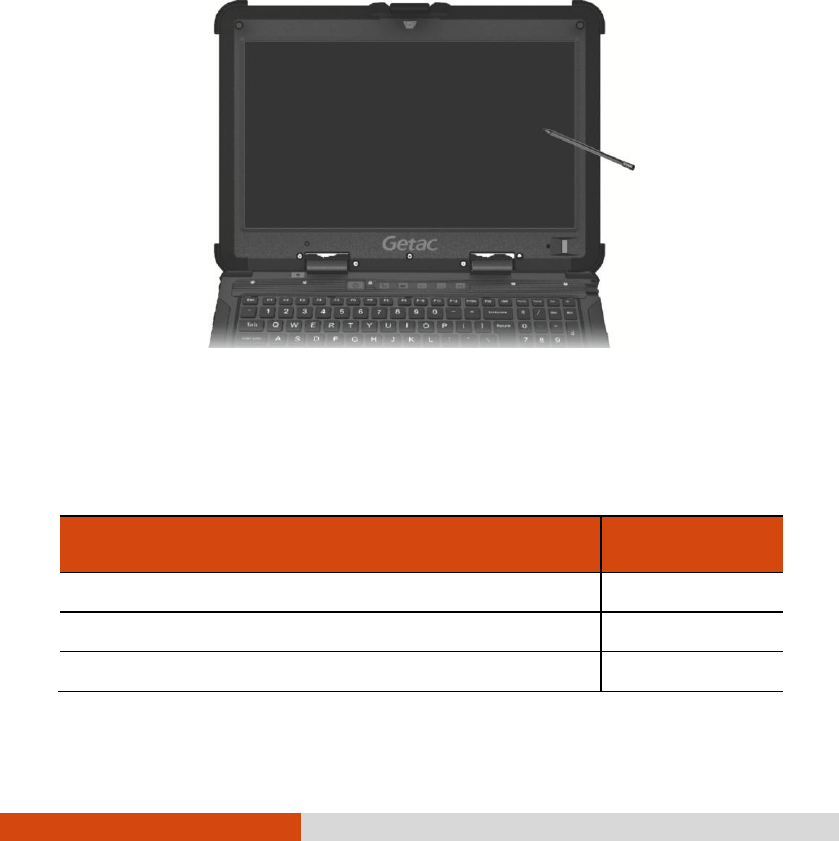
23
Using the Touchscreen (Optional)
CAUTION: Do not use a sharp object such as a ballpoint pen or
pencil on the touchscreen. Doing so may damage the touchscreen
surface.
The touchscreen is a touch-sensitive device that allows you to navigate on the screen
without using a keyboard, touchpad, or mouse.
Use the included stylus to select objects on the screen. The stylus can be stretched
for better grip and handling.
The following table shows how you use the touchscreen to obtain equivalent mouse
functions.
Term/Action
Equivalent Mouse
Function
Tap: Touch the screen once.
Click/Point
Double-tap: Touch the screen twice rapidly.
Double-click
Tap and hold: Tap and hold until a popup menu appears.
Right-click
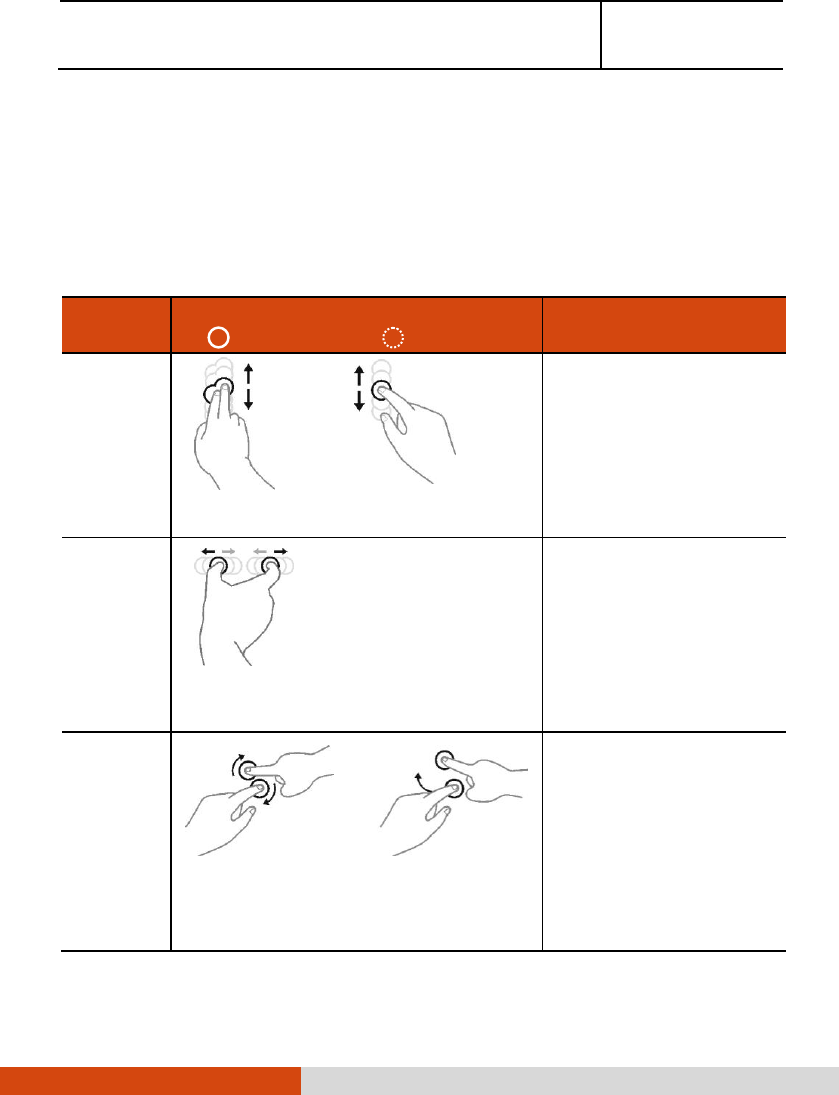
24
Drag: Hold the stylus (or finger) on the screen and drag
across the screen until reaching your destination.
Drag
Using Multi-touch Gestures (Optional)
You can interact with your computer by placing two fingers on the screen. The
movement of the fingers across the screen creates “gestures,” which send commands
to the computer.
Here are the multi-touch gestures that you can use:
Gestures
Actions
( = finger down; = finger up)
Descriptions
Pan
(Scroll)
or
Drag 1 or 2 fingers up or down.
Use panning to see
another part of a page that
has scroll bars.
Zoom
(Pinch)
Move two fingers apart/toward each
other.
Use zooming to make an
item (a photo for
example) on the screen
larger or smaller. The
gesture works in
applications that support
mouse wheel zooming.
Rotate
or
Move two fingers in opposing directions.
-or-
Use one finger to pivot around another.
Use rotating to move a
picture or other item on
the screen in a circular
direction (clockwise or
counter-
clockwise). The gesture
works in applications that
support the specific
gesture.
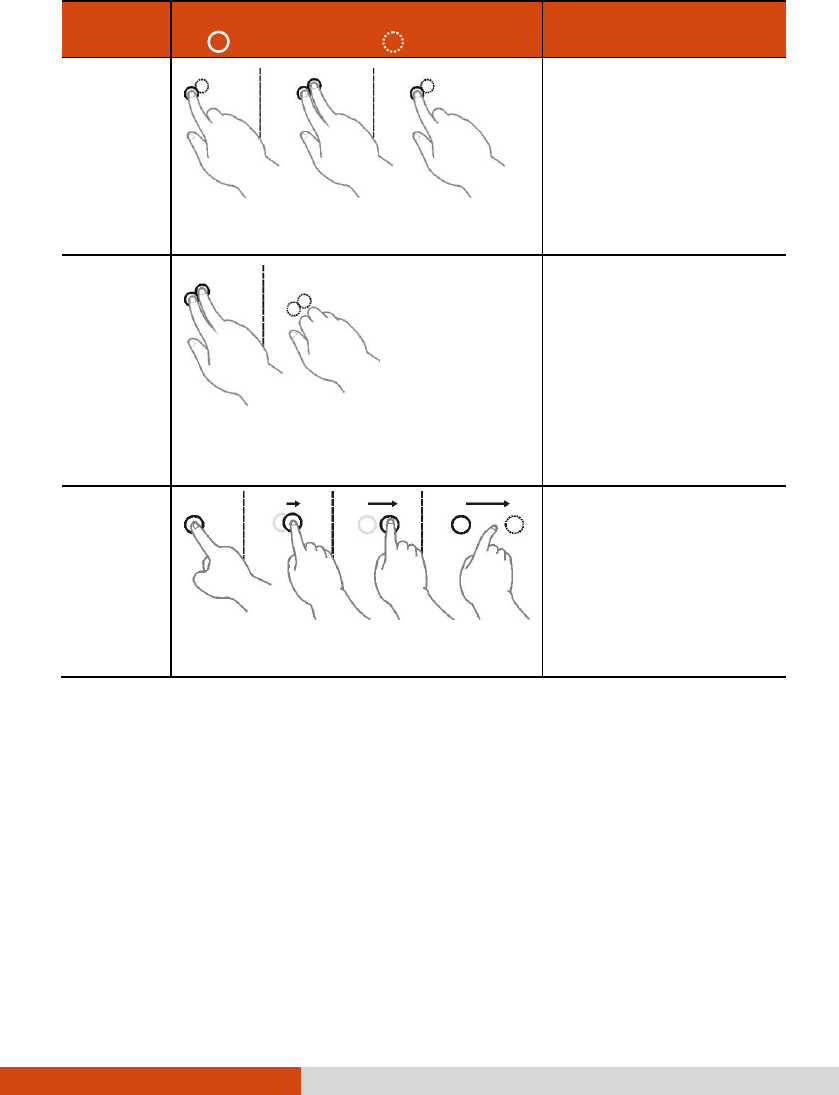
25
Gestures
Actions
( = finger down; = finger up)
Descriptions
Press and
Tap
Press on target and tap using a second
finger.
Use press and tap to
access the shortcut menu.
Two-
finger Tap
Tap two fingers at the same time (where
the target is in the midpoint between the
fingers).
The function is defined by
applications that support
the specific gesture.
Flicks
Make quick drag gestures in the desired
direction.
Flick left or right to
navigate back and forward
in a browser and other
applications. The gesture
works in most applications
that support back and
forward.
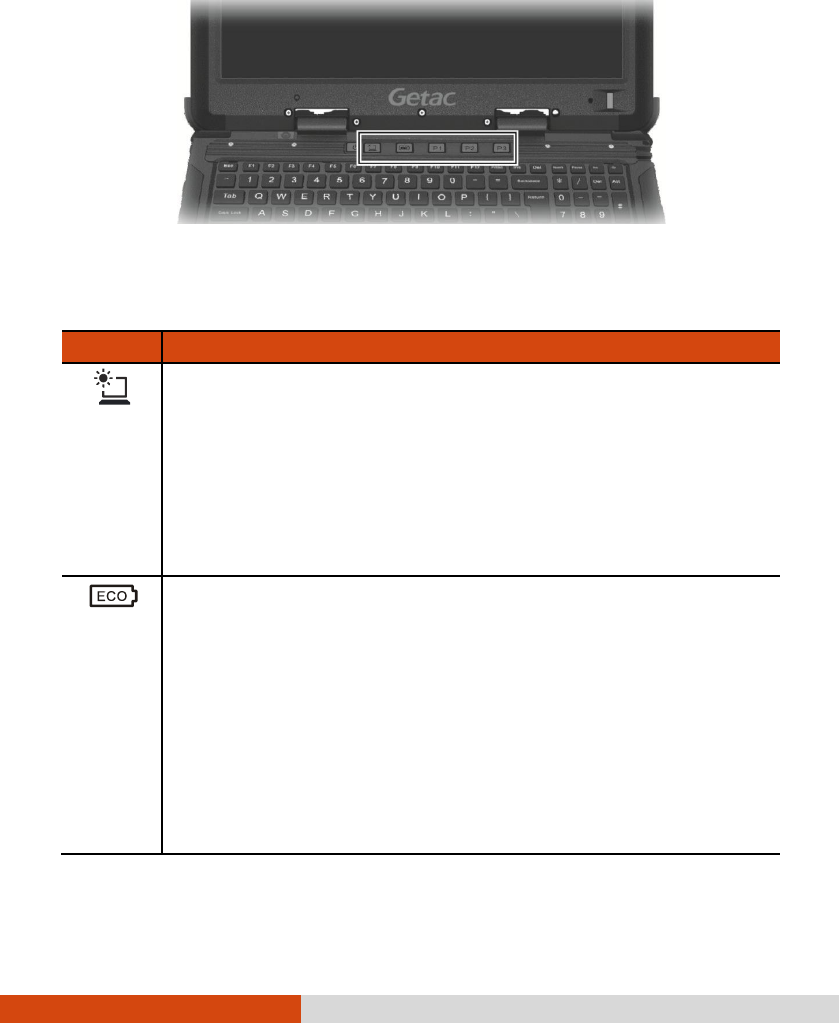
26
Using the Quick Buttons
The Quick Buttons allow you to quickly start a program or activate a function. Default
functions are:
Button
Description
Toggles the sunlight-readable mode on or off. An OSD (On Screen
Display) pops up on the screen indicating the current status (MAX for
on and MANUAL for off).
In sunlight-readable mode, the LCD brightness is increased to the highest
level. The mode automatically ends when the brightness setting is
changed, the computer resumes from Sleep/Hibernation mode, or the
computer is restarted.
NOTE: The button works only when using battery power.
Switches the ECO mode to the next choice (QUICK MODE, MAX POWER
SAVING, WORK MODE, or OFF). An OSD (On Screen Display) pops
up on the screen indicating the current status.
The ECO mode will return to the default OFF setting when AC power
is connected, any power related setting is changed, the computer
resumes from Sleep/Hibernation mode, or the computer is restarted.
Each ECO mode is a combination of power settings that results in
different power consumptions.
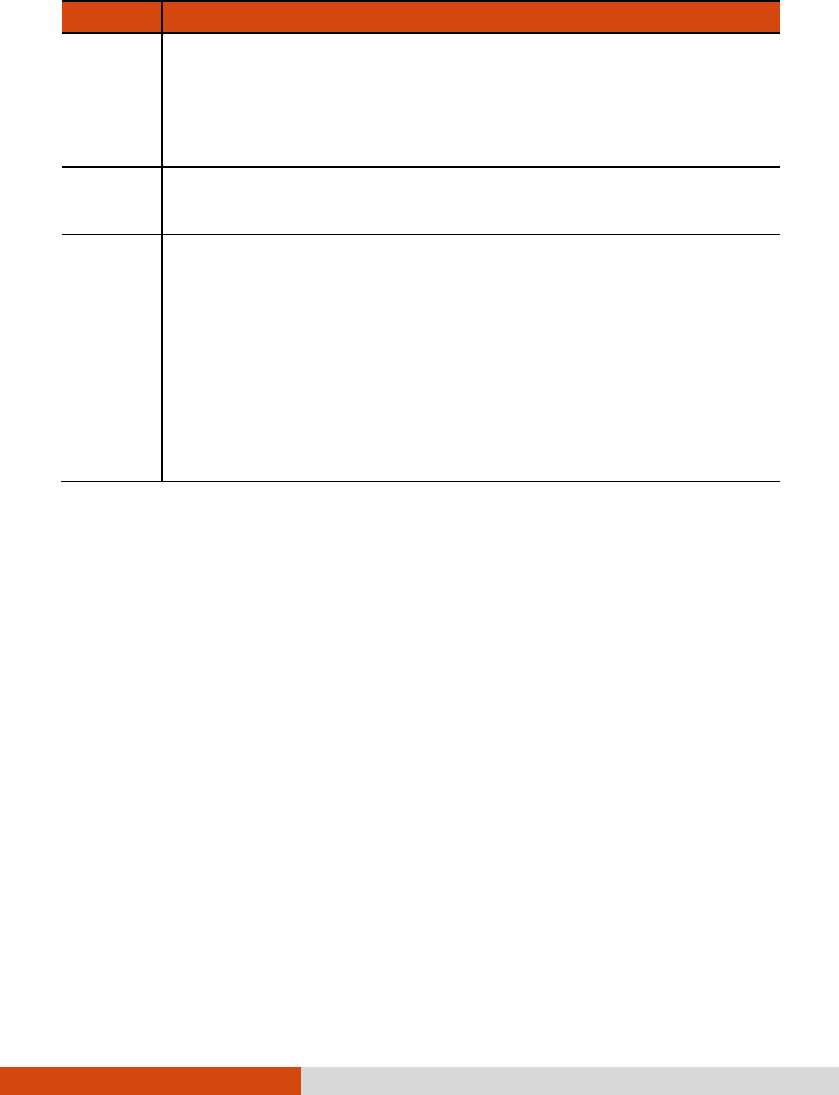
27
Button
Description
P1
Toggles Blackout mode on or off.
In Blackout mode, the LCD backlight, keyboard/button backlight, and
LED indicators are all turned off; and the sound is muted.
To bring the computer out of Blackout mode, press the power button.
P2
Toggles the touchpad off or on. An OSD (On Screen Display) pops
up on the screen indicating the current status.
P3
Toggles the light sensor on or off. An OSD (On Screen Display) pops
up on the screen indicating the current status (AUTO for on and MANUAL
for off).
When set to AUTO, the brightness will be automatically adjusted according
to the current ambient light.
The backlight will return to the default MANUAL setting whenever the
computer resumes from Sleep/Hibernation mode or the computer is
restarted.
Configuring the Quick Buttons
The button functions can be redefined. Use the G-Manager program and select
the Buttons tab to configure the buttons. (See “G-Manager” in Chapter 6 for
information.)
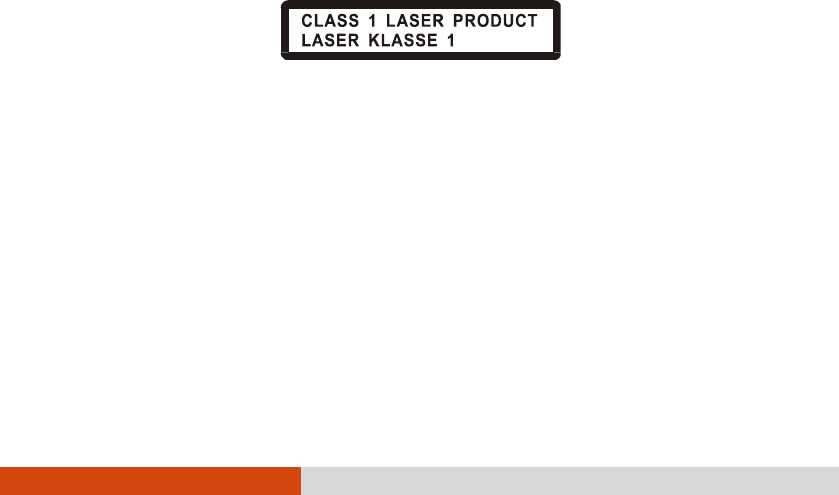
28
Using the DVD Drive
Your computer comes with a Super Multi drive. The drive can read from and write
to CD, DVD+, DVD- and DVD-RAM media.
CAUTION:
When inserting a disc, do not use force.
Make sure that the disc is correctly inserted into the tray,
and then close the tray.
Do not leave the drive tray open. Also, avoid touching the
lens in the tray with your hand. If the lens becomes dirty,
the drive may malfunction.
Do not wipe the lens using materials with rough surface (such
as paper towel). Instead, use a cotton swab to gently wipe
the lens.
FDA regulations require the following statement for all
laser-based devices:
“Caution, Use of controls or adjustments or performance of
procedures other than those specified herein may result in
hazardous radiation exposure.”
NOTE: The DVD drive is classified as a Class 1 laser product.
This label is located on the DVD drive.
NOTE: This product incorporates copyright protection
technology that is protected by method claims of certain U.S.
patents and other intellectual property rights owned by
Macrovision Corporation and other rights owners. Use of this
copyright protection technology must be authorized by
Macrovision Corporation, and is intended for home and other
limited viewing uses only unless otherwise authorized by
Macrovision Corporation. Reverse engineering or disassembly is
prohibited.
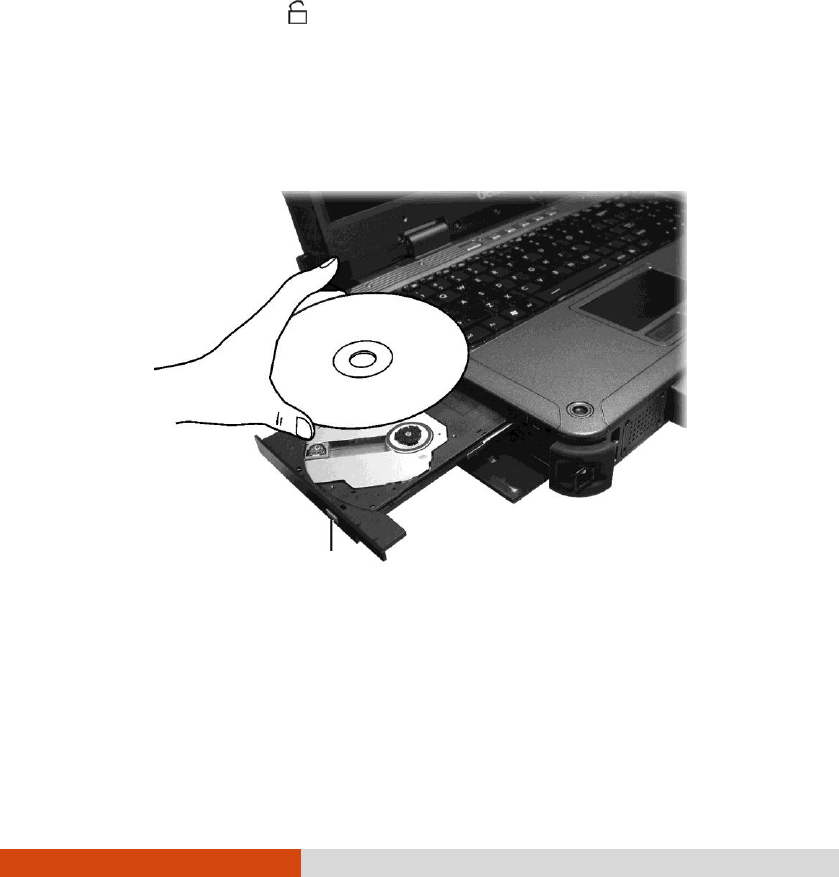
29
Inserting and Removing a Disc
1. Turn on the computer.
2. Locate the DVD drive on the left side of your computer. Slide the latch toward
the right to unlock ( ) and then push down the latch to release the cover.
3. Press the eject button and the DVD tray will slide out partially. Gently pull on
it until it is fully extended.
4. To insert a disc, place down the disc in the tray with its label facing up. Slightly
press the center of the disc until it clicks into place.
To remove a disc, hold the disc by its outer edge and lift it up from the tray.
5. Gently push the tray back into the drive.
6. Close the cover.
NOTE: In the unlikely event that you are unable to release the
drive tray by pressing the eject button, you can manually
Eject Button
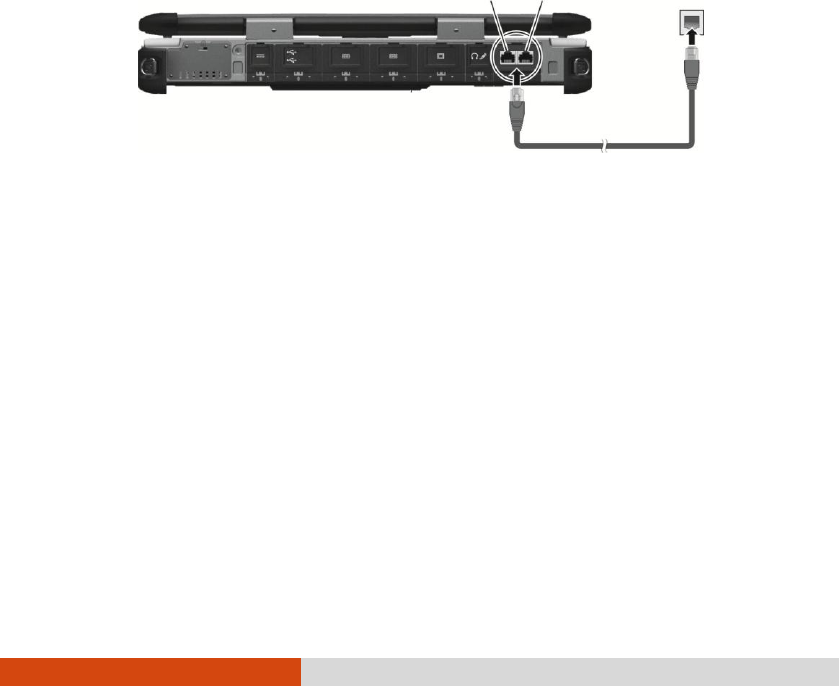
31
Using Network and Wireless
Connections
Using the LAN
The internal 10/100/1000Base-T LAN (Local Area Network) module allows you
to connect your computer to a network. It supports data transfer rate up to 1000
Mbps.
To connect the network cable to the LAN module, connect one end of the LAN
cable to the RJ-45 connector on the computer and the other end to the network
hub.
Your computer supports two LAN modules (LAN1 and LAN2) so you can connect
to two networks at the same time.
LAN2
LAN1

32
Using the WLAN
The WLAN (Wireless Local Area Network) module supports IEEE 802.11ac,
compatible with 802.11a/b/g/n.
Turning On/Off the WLAN Radio
If you have previously turned off the WLAN radio, use this method to turn it on.
Click Settings Network & Internet Wi-Fi. Slide the Wi-Fi switch to the
On position
To turn off the WLAN radio:
You can turn off the WLAN radio the same way you turn it on.
If you want to quickly turn off all wireless radio, simply switch on Airplane mode.
Click Settings Network & Internet Airplane mode. Slide the Airplane
mode switch to the On position. You can also press Fn+F2 to switch Airplane mode
on or off.
Connecting to a WLAN Network
1. Make sure that the WLAN function is enabled (as described above).
2. Click the network icon in the lower right of the task bar.
3. In the list of available wireless networks, select a network, and then select
Connect.
4. Some networks require a network security key or passphrase. To connect to
one of those networks, ask your network administrator or Internet service provider
(ISP) for the security key or passphrase.
For more information on setting a wireless network connection, refer to Windows
online help.
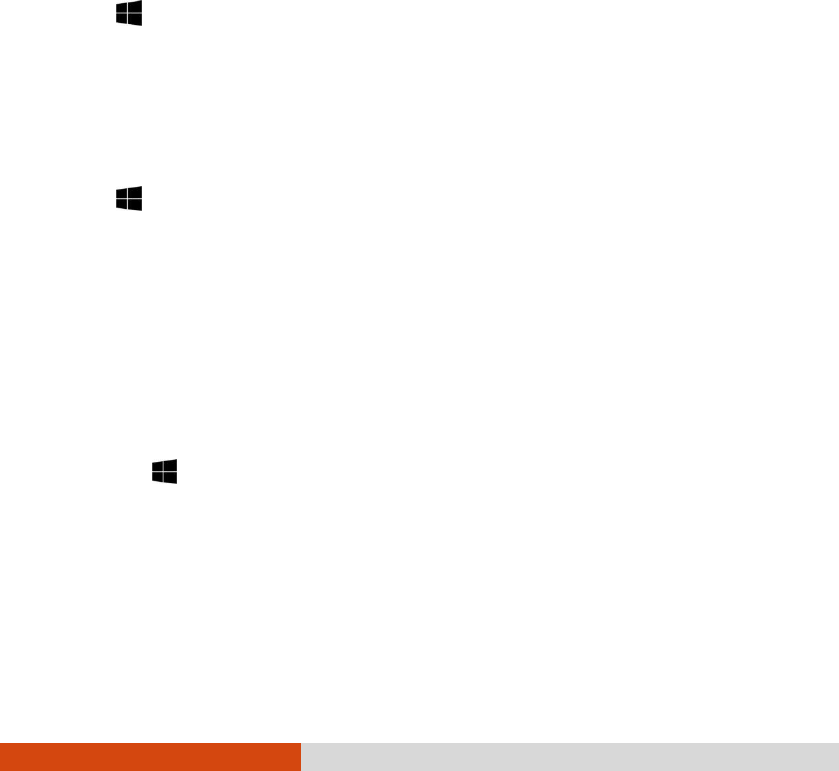
33
Using the Bluetooth Feature
The Bluetooth technology allows short-range wireless communications between
devices without requiring a cable connection. Data can be transmitted through walls,
pockets and briefcases as long as two devices are within range.
Turning On/Off the Bluetooth Radio
To turn on the Bluetooth radio:
If you have previously turned off the Bluetooth radio, use this method to turn it
on.
Click Settings Devices Bluetooth. Slide the Bluetooth switch to the
On position.
To turn off the Bluetooth radio:
You can turn off the Bluetooth radio the same way you turn it on.
If you want to quickly turn off all wireless radio, simply switch on Airplane mode.
Click Settings Network & Internet Airplane mode. Slide the Airplane
mode switch to the On position. You can also press Fn+F2 to switch Airplane mode
on or off.
Connecting to another Bluetooth Device
1. Make sure that the Bluetooth function is enabled (as described above).
2. Make sure that the target Bluetooth device is turned on, discoverable and within
close range. (See the documentation that came with the Bluetooth device.)
3. Click Settings Devices Bluetooth.
4. Select the device you want to connect from the search results.
5. Depending on the type of Bluetooth device that you want to connect to, you
will need to enter the pertinent information.
For detailed information on using the Bluetooth feature, see Windows’ online Help.
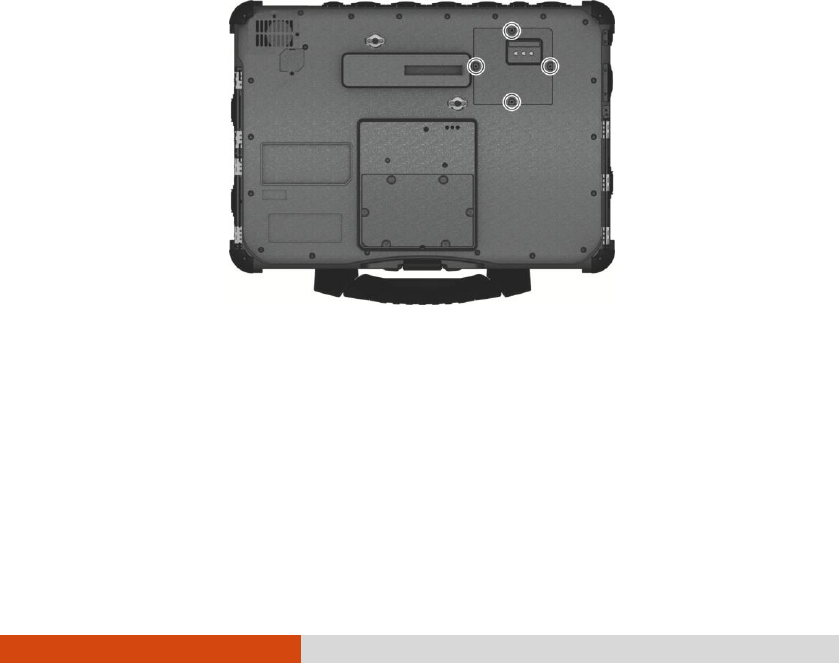
34
Using the WWAN Feature (Optional)
A WWAN (Wireless Wide Area Network) uses mobile telecommunication cellular
network technologies to transfer data. The WWAN module of your computer supports
3G.
NOTE: Your model only supports data transmission. Voice
transmission is not supported.
Installing a SIM Card
1. Turn off the computer and disconnect the AC adapter.
2. Carefully place the computer upside down.
3. Unfasten four screws and flip open the cover. Be careful not to pull on the
cables connected to the cover.
4. Locate the SIM card slot. Locate the SIM card slot. Slide the locking tab inward
to unlock (). Lift the slot up and, noting the orientation, insert the SIM card
into the slot (). Slide the locking tab outward to secure the SIM card in
place ().
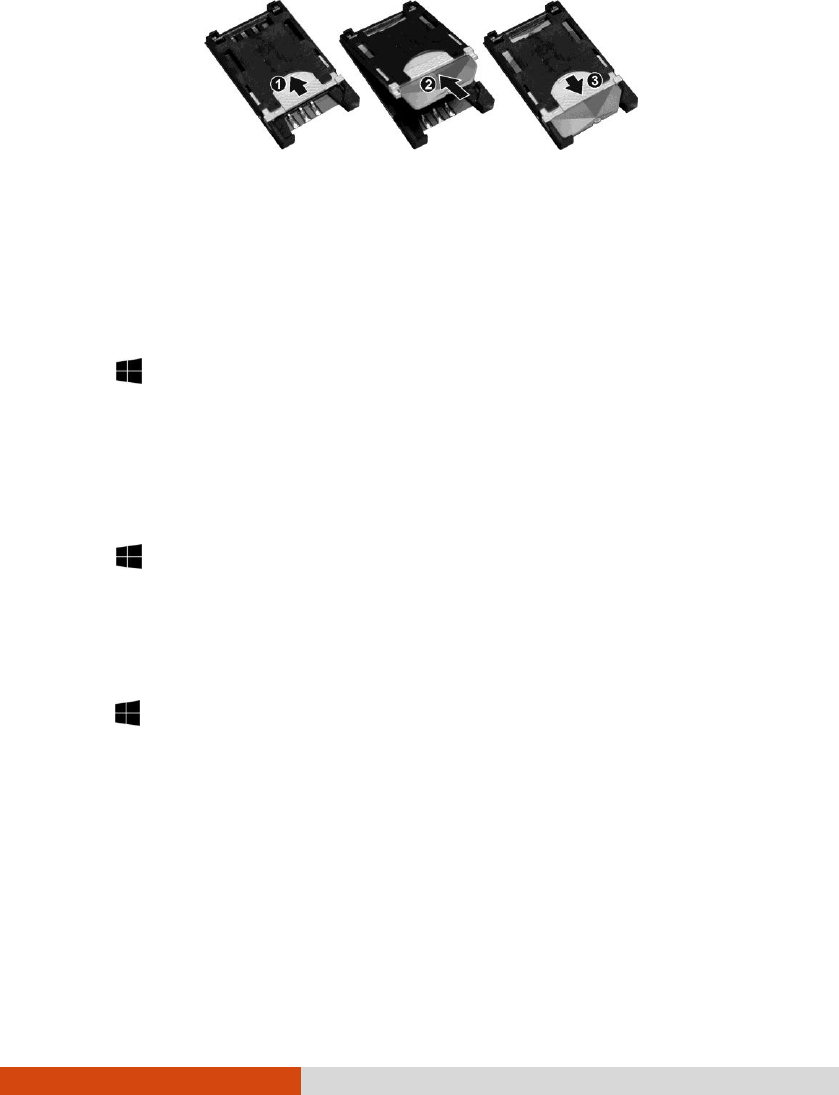
35
5. Close the cover and secure with four screws.
Turning On/Off the WWAN Radio
To turn on the WWAN radio:
If you have previously turned off the WWAN radio, use this method to turn it on.
Click Settings Network & Internet Airplane mode. Slide the Cellular
switch to the On position.
To turn off the WWAN radio:
You can turn off the WWAN radio the same way you turn it on.
If you want to quickly turn off all wireless radio, simply switch on Airplane mode.
Click Settings Network & Internet Airplane mode. Slide the Airplane
mode switch to the On position. You can also press Fn+F2 to switch Airplane mode
on or off.
Setting up a WWAN Connection
Click Settings Network & Internet Cellular. (For detailed information on
cellular settings in Windows 10, see Microsoft Support website.)
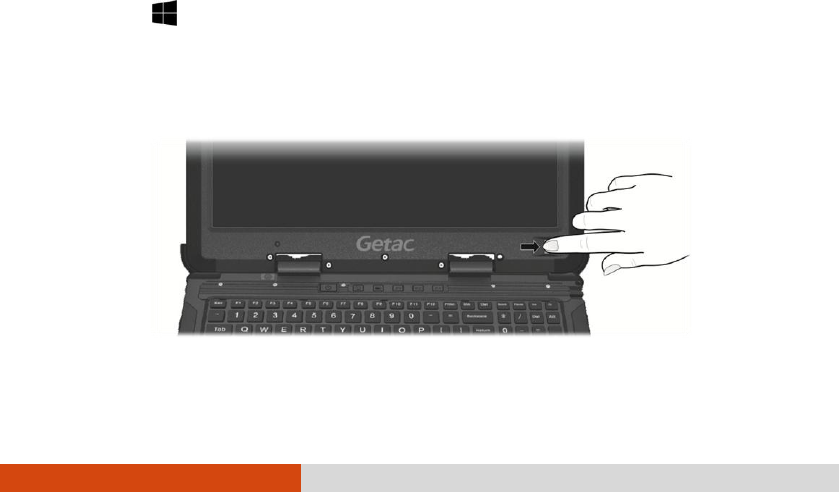
36
Using the Fingerprint Scanner
(Optional)
WARNING:
We shall not be liable for any loss or damage whatsoever
resulting from your use of the fingerprint scanner or neglect
of fingerprint scanner use, or any data loss resulting from
such developments as fingerprint authentication
malfunctioning.
It is not recommended that you use the fingerprint scanner
in a below-
freezing temperature. The moisture on your finger can freeze
to the scanner’s metal surface when you touch it, resulting
in a failed operation. Besides, touching freezing metal with
your finger can cause frostbite.
The fingerprint scanner provides a strong authentication mechanism based on
fingerprint recognition.
To enroll your fingerprint and configure the function:
NOTE: You can enroll a fingerprint only after creating a
password for the Windows user account.
1. Click Settings Accounts Sign-in options.
2. On the right side under Fingerprint, click Set up.
3. Follow the onscreen instructions to complete.

37
NOTE: The fingerprint logon process can take a while. This is
because the system has to check hardware devices and security
configuration before initiating the fingerprint scanner.

38
Chapter 3
Chapter 3 Managing Power
Your computer operates either on external AC power or on internal battery power.
This chapter tells you how you can effectively manage power. To maintain optimal
battery performance, it is important that you use the battery in the proper way.

39
AC Adapter
CAUTION:
The AC adapter is designed for use with your computer only.
Connecting the AC adapter to another device can damage the
adapter.
The AC power cord supplied with your computer is for use in
the country where you purchased your computer. If you plan
to go overseas with the computer, consult your dealer for the
appropriate power cord.
When you disconnect the AC adapter, disconnect from the
electrical outlet first and then from the computer. A reverse
procedure may damage the AC adapter or computer.
When unplugging the connector, always hold the plug head.
Never pull on the cord.
The AC adapter serves as a converter from AC (Alternating Current) to DC (Direct
Current) power because your computer runs on DC power, but an electrical outlet
usually provides AC power. It also charges the battery pack when connected to AC
power.
The adapter operates on any voltage in the range of 100~240 V AC.
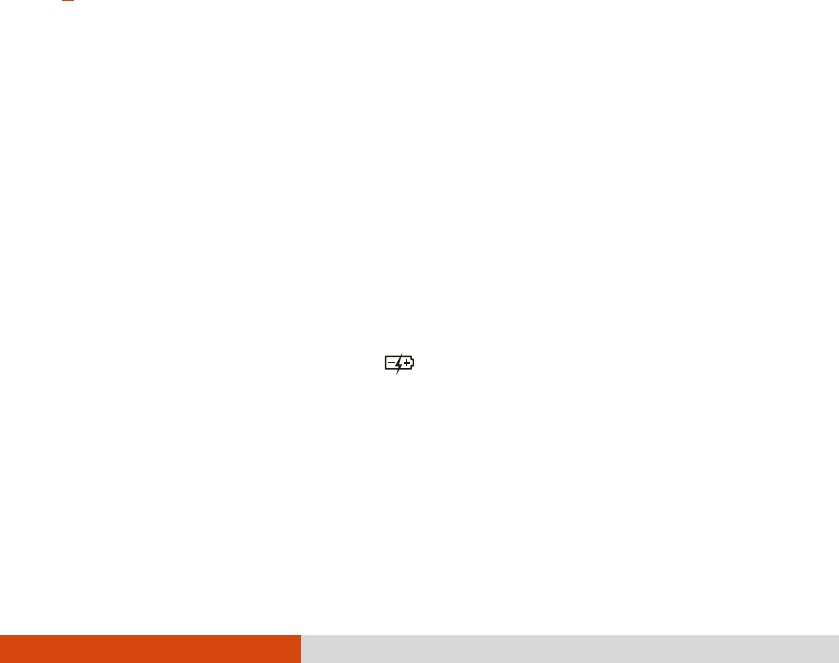
40
Battery Pack
The battery pack is the internal power source for the computer. It is rechargeable
using the AC adapter.
The operating time of a fully charged battery pack depends on how you are using
the computer. When your applications often access peripherals, you will experience
a shorter operating time.
NOTE: Care and maintenance information for the battery is
provided in the “Battery Pack Guidelines” section in Chapter
7.
Charging the Battery Pack
NOTE:
Charging will not start if the battery’s temperature is below
0 C (32 F) or above 40 C (104 F); the charging process
will stop if the battery’s temperature gets above 60 C (140
F). To avoid damaging the battery under this situation,
disconnect the AC adapter and wait for the battery to return
to room temperature before charging again.
During charging, do not disconnect the AC adapter before the
battery has been fully charged; otherwise you will get a
prematurely charged battery.
The battery level may automatically lessen due to the
self-discharge process, even when the battery pack is fully
charged. This happens no matter if the battery pack is
installed in the computer.
To charge the battery pack, connect the AC adapter to the computer and an electrical
outlet. The Battery Charge Indicator ( ) on the computer glows amber to indicate
that charging is in progress. You are advised to keep the computer power off while
the battery is being charged. When the battery is fully charged, the Battery Charge
Indicator glows green.
It takes approximately 4 hours to fully charge the Li-Ion battery pack when the
computer is off, and approximately 7 hours to fully charge the battery pack when
the computer is on.

41
CAUTION: After the computer has been fully recharged, do not
immediately disconnect and reconnect the AC adapter to charge
it again. Doing so may damage the battery.
Initializing the Battery Pack
You need to initialize a new battery pack before using it for the first time or when
the actual operating time of a battery pack is much less than expected. Initializing
is the process of fully charging, discharging, and then charging. It can take several
hours.
A software tool called “Gauge Reset” is provided for the purpose. Use the G-Manager
program and select the Battery tab to find the tool.
Checking the Battery Level
NOTE: Any battery level indication is an estimated result. The
actual operating time can be different from the estimated time,
depending on how you are using the computer.
By Operating System
You can check the approximate battery level using the battery meter function of the
operating system. To read the battery level in Windows, click the battery icon on the
taskbar.
By Gas Gauge
On the exterior side of the battery pack is a gas gauge for displaying the estimated
battery charge. When the battery pack is not installed in the computer and you want
to know the battery charge, you can press the push-button to see the number of
LEDs that light up. Each LED represents 25% charge.
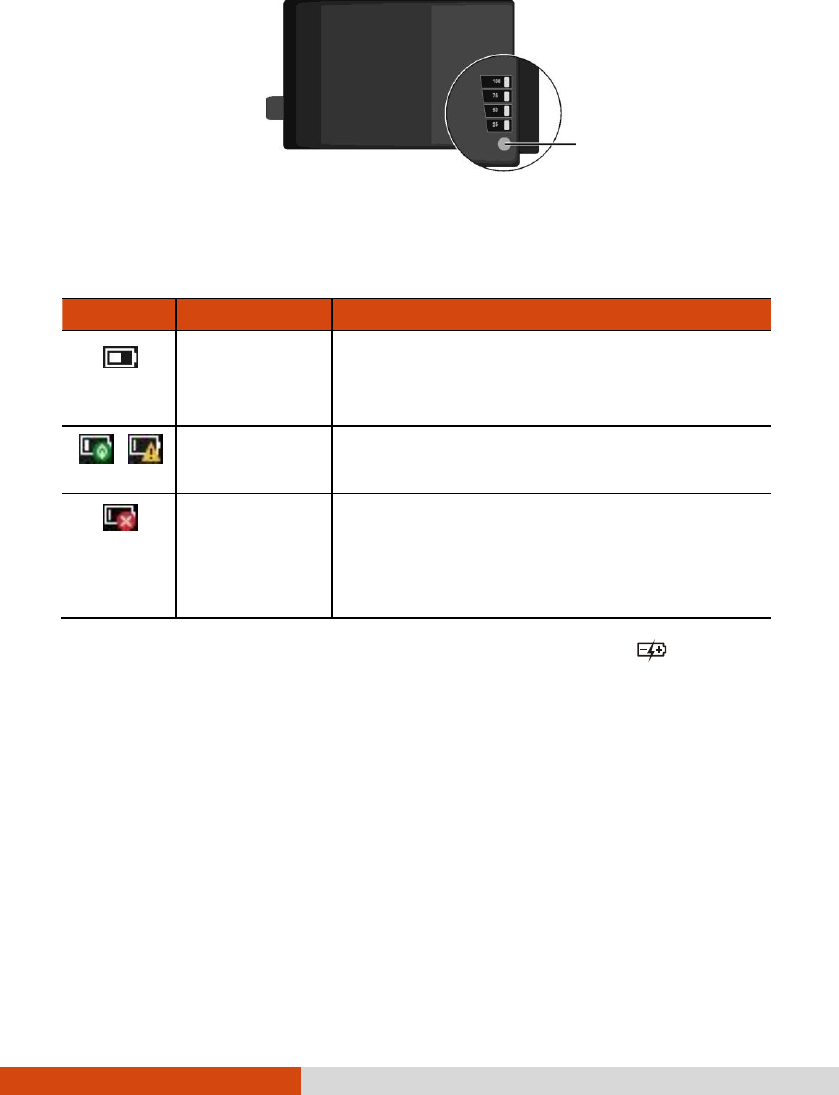
42
Battery Low Signals and Actions
The battery icon changes appearance to display the current state of the battery.
Battery Icon
Battery Level
Description
Discharging
The icon shows the charge remaining in
10-percent increments until the charge reaches
the low-battery level.
Low
The battery charge has reached the low-battery
level (10% by default).
Critically low
The battery charge has reached the critical battery
level (5% by default). By default, Windows will
display a notification and put your computer into
Hibernation.
When the battery is low, the computer’s Battery Charge Indicator ( ) also blinks
red to alert you to take actions.
Always respond to low-battery by connecting the AC adapter, placing your computer
in Hibernation mode, or turning off the computer.
Push-button
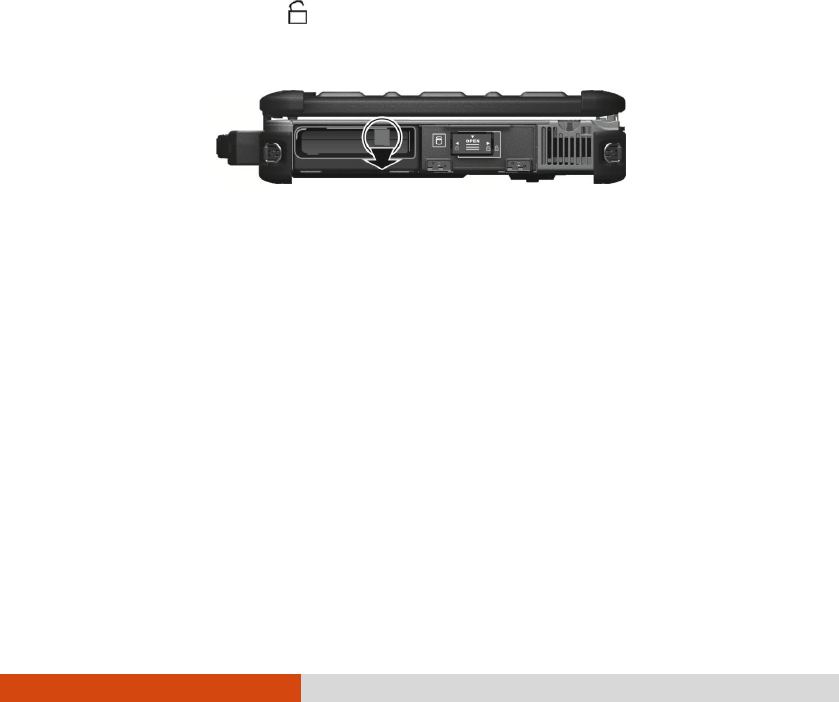
43
Replacing the Battery Pack
CAUTION:
There is danger of explosion if the battery is incorrectly
replaced. Replace the battery only with the computer
manufacturer’s optional battery packs. Discard used
batteries according to the dealer’s instructions.
Do not attempt to disassemble the battery pack.
1. Turn off the computer and disconnect the AC adapter.
2. Locate the battery pack on the right side of your computer. Slide the latch toward
the right to unlock ( ) and then push down the latch to release the cover.
3. Pull the strip and slide the battery pack out of the slot.
4. With the strip facing outward, insert the new battery pack all the way into the
slot.
5. Close the cover.

44
Power-Saving Tips
Aside from enabling your computer’s power saving mode, you can do your part to
maximize the battery’s operating time by following these suggestions.
Do not disable Power Management.
Decrease the LCD brightness to the lowest comfortable level.
Shorten the length of time before Windows turn off the display.
When not using a connected device, disconnect it.
Remove the card (such as smart card, ExpressCard, or PC card) if not using
it.
Turn off the wireless radio if you are not using the wireless module (such as
WLAN, Bluetooth, or WWAN).
Turn off the computer when you are not using it.

45
Chapter 4
Chapter 4 Expanding Your
Computer
You can expand the capabilities of your computer by connecting other peripheral
devices.
When using a device, be sure to read the instructions accompanying the device
together with the relevant section in this chapter.
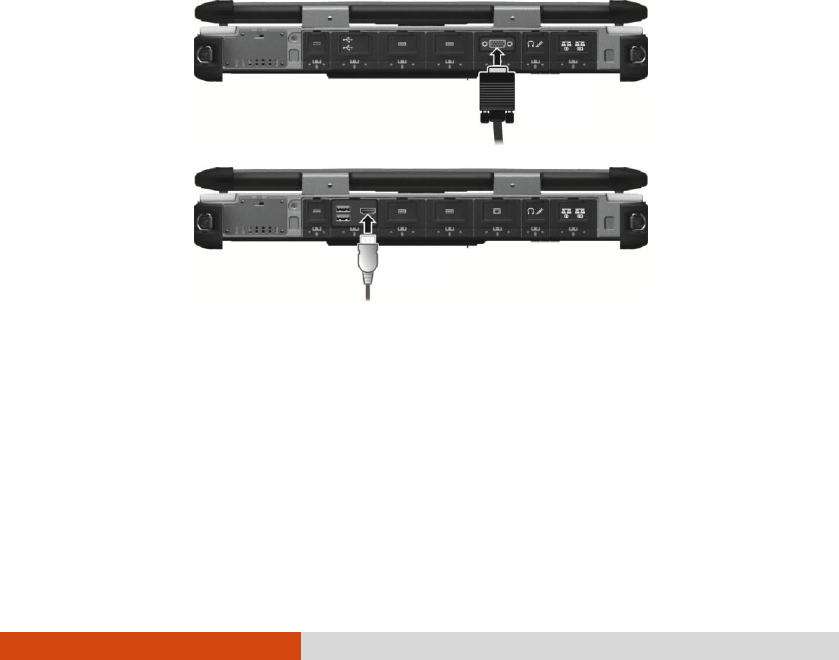
46
Connecting Peripheral Devices
Connecting Display Monitor
If you want the benefits of a larger display screen with higher resolution, you can
connect an external display monitor to your computer.
Your computer supports a VGA connector and a HDMI connector. HDMI
(High-Definition Multimedia Interface) is an audio/video interface that transmits
uncompressed digital data and therefore delivers true HD quality.
1. Turn off the computer.
2. Depending on the type of your monitor, plug the monitor’s signal connector to
the computer’s VGA or HDMI connector.
3. Plug one end of the monitor’s power cord into the power socket on the monitor
and the other end to an electrical outlet.
4. To use the monitor, turn on the monitor before turning on the computer.
5. The connected device should respond by default. If not, you can switch the
display output by pressing the Fn+F9 hot keys. (You can also change the display
through Windows Control Panel Display Settings Properties.)
VGA
HDMI
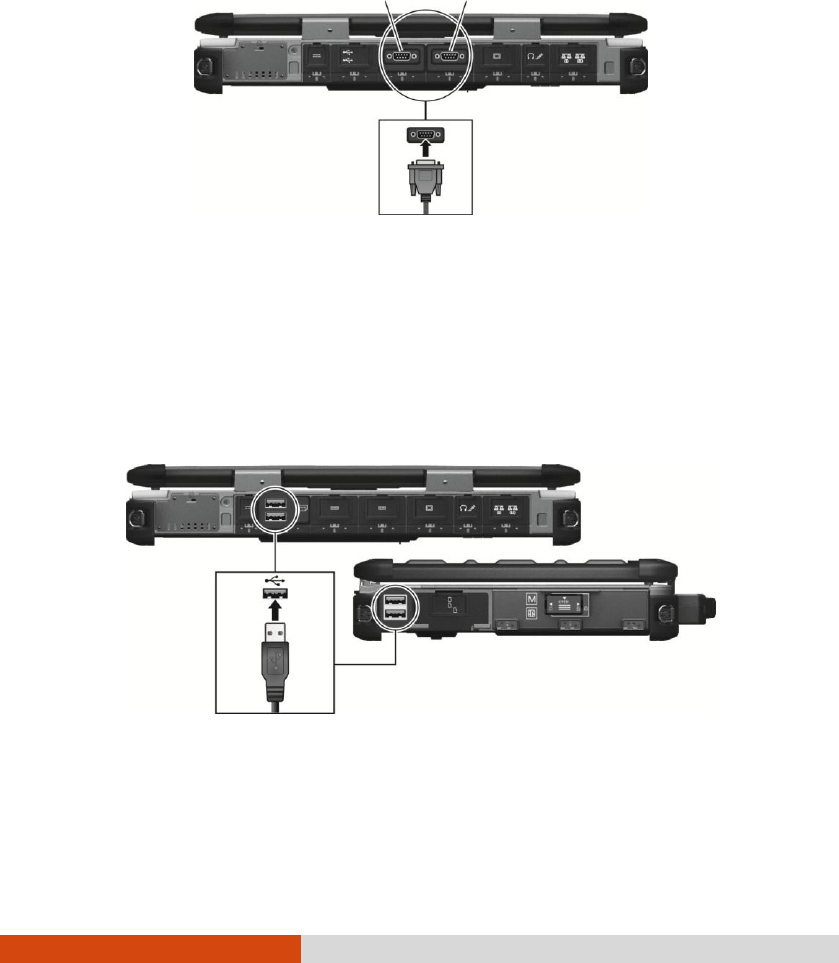
47
Connecting a Serial Device
Your computer has two serial ports for connecting a serial device.
NOTE: The serial port is configured as RS232 by default. If you
want to use it as RS422, run BIOS Setup to change the setting.
(See “Advanced Menu” in Chapter 5 for information.)
Connecting a USB Device
Your computer has four USB 3.0 ports for connecting USB devices, such as a digital
camera, scanner, printer, modem, and mouse.
COM1
COM2
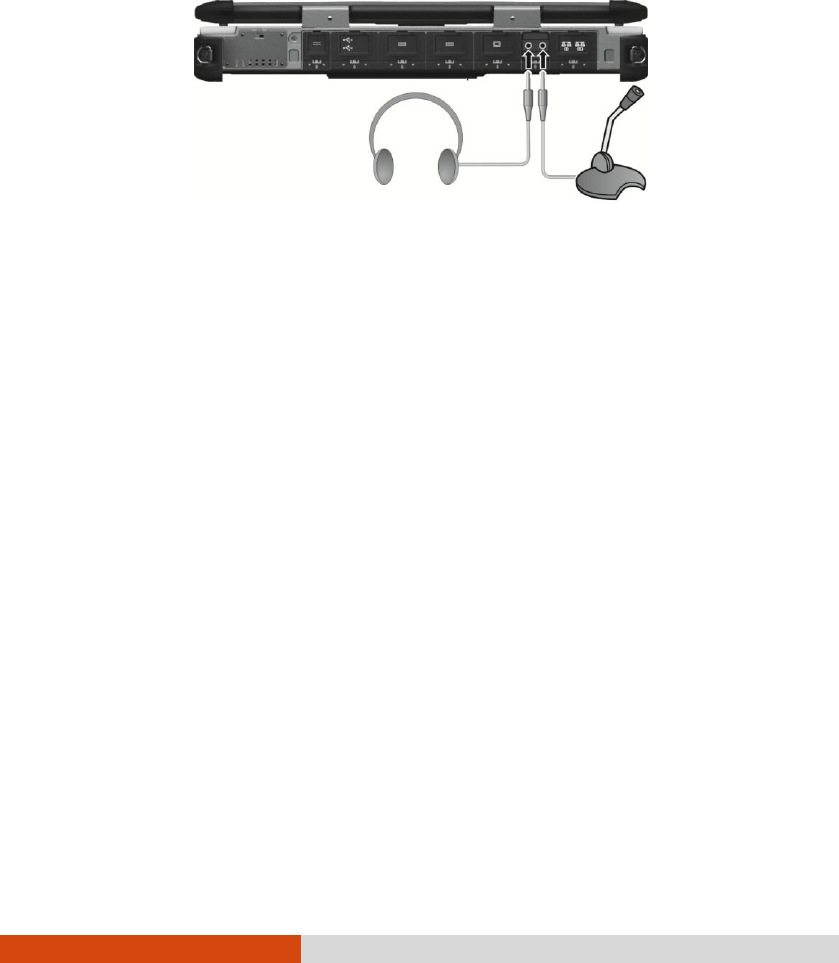
48
Connecting an Audio Device
For higher audio quality, you can send or receive sound through external audio
devices.
Audio Output Connector can be connected to speakers, headphones, or earphone
set.
Microphone Connector can be connected to an external microphone for recording
voice or sound.
NOTE:
After connecting an external audio device, make sure that
you specify the use of the correct audio device in Windows.
When using the external speakers/headphones or microphone,
you cannot use the internal one.
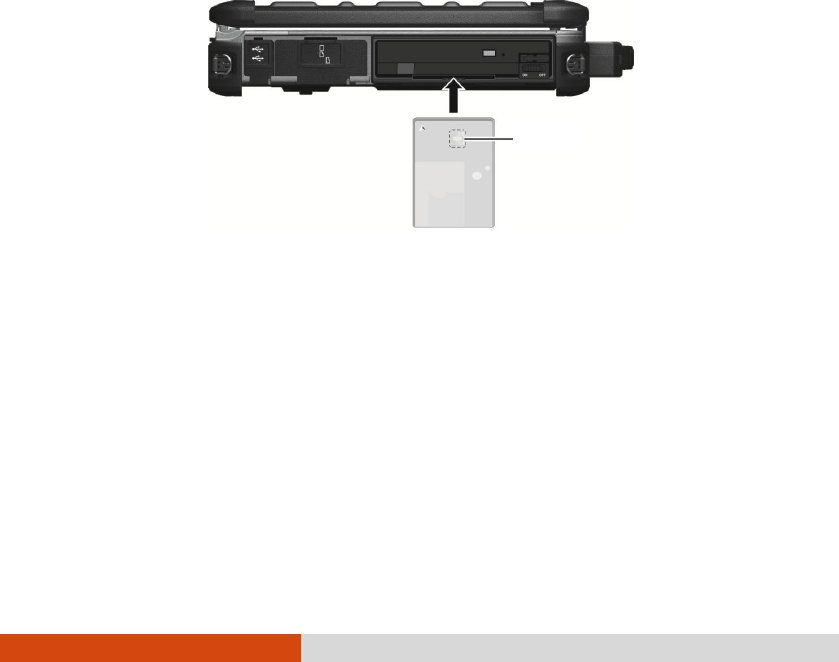
49
Using Storage and Expansion Cards
Using Smart Cards
Your computer has a smart card slot.
With an embedded microcontroller, smart cards have the unique ability to store large
amounts of data, carry out their own on-card functions (e.g., encryption and mutual
authentication), and interact intelligently with a smart card reader.
To insert a smart card:
1. Locate the smart card slot on the left side of the computer and open the protective
cover.
2. Slide the smart card, with its label and embedded chip facing up into the slot.
3. Close the cover.
To remove a smart card:
1. Make sure that the software is not accessing the smart card.
2. Pull the card out of the slot.
3. Close the cover.
Chip
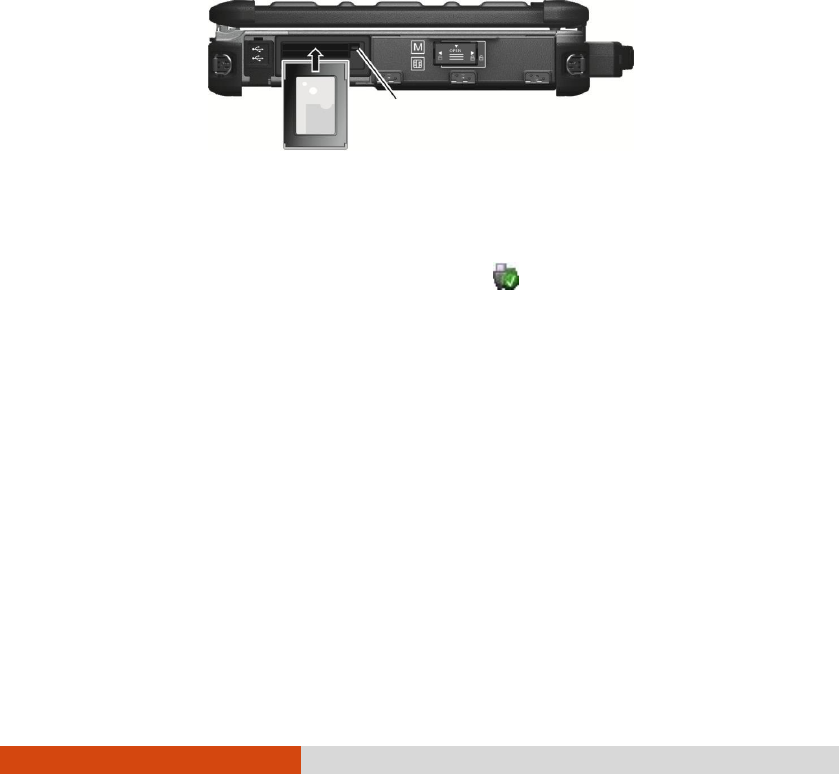
50
Using PC Cards
Your computer has a PC card slot which supports PCMCIA Type II and CardBus
specifications.
To insert a PC card:
1. Locate the PC card slot on the left side of the computer and open the protective
cover.
2. Slide the PC card, with its label facing up, into the slot until the eject button
pops out.
3. Close the cover.
To remove a PC card:
1. Double-click on the Safely Remove Hardware icon found on the Windows
taskbar and the Safely Remove Hardware window appears on screen.
2. Select (highlight) the PC card from the list to disable the card.
3. Push the eject button and the card will slide out slightly. Pull the card out of
the slot.
4. Close the cover.
Eject button
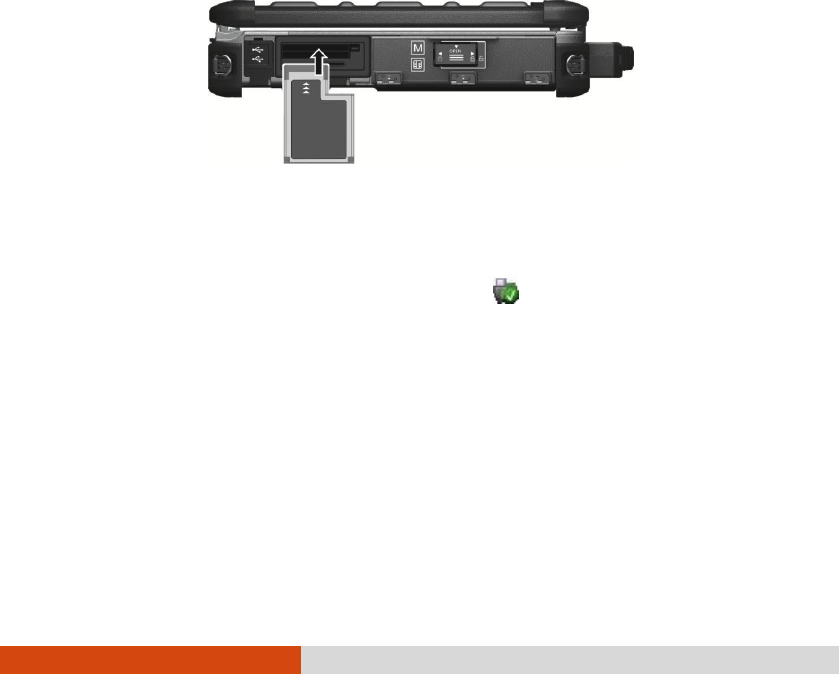
51
Using ExpressCards
Your computer has an ExpressCard slot.
The ExpressCard slot can accommodate a 54 mm (ExpressCard/54) or 34 mm
(ExpressCard/34) wide ExpressCard. Typical ExpressCards support a very extensive
range of applications including memory, wired and wireless communication cards,
and security devices.
To insert an ExpressCard:
1. Locate the ExpressCard slot on the left side of the computer and open the
protective cover.
2. Slide the ExpressCard, with its label facing up, all the way into the slot until
the rear connectors click into place.
3. Close the cover.
To remove an ExpressCard:
1. Double-click on the Safely Remove Hardware icon found on the Windows
taskbar and the Safely Remove Hardware window appears on screen.
2. Select (highlight) the ExpressCard from the list to disable the card.
3. Slightly push the card to release and then pull it out of the slot.
4. Close the cover.
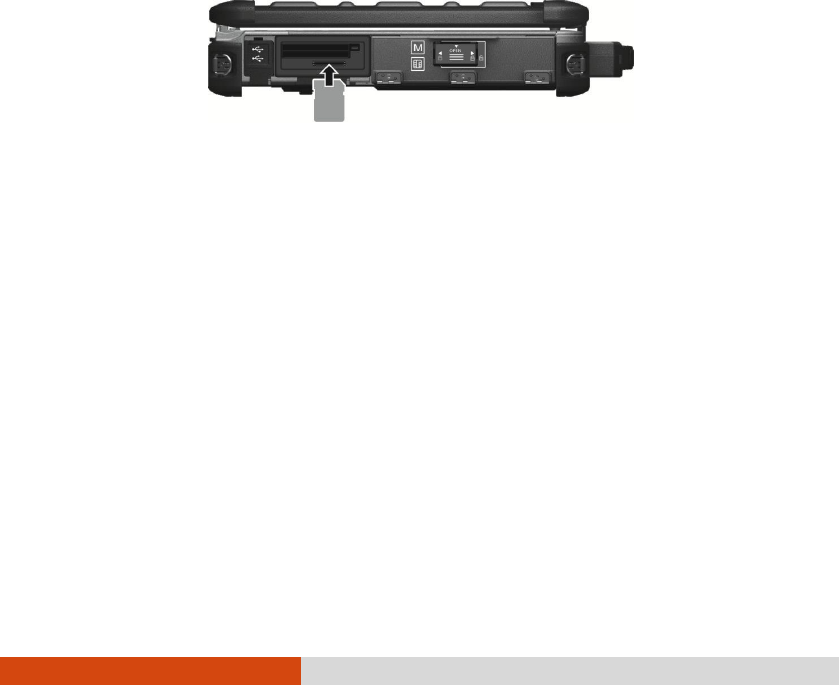
52
Using Storage Cards
NOTE: You can use only storage cards. Your Card Reader does not
support cards with I/O (input/output) functions such as a
wireless network card or Bluetooth card.
Your computer has a storage card reader. The card reader is a small drive for
reading from and writing to removable storage cards (or called memory cards).
The reader supports SD (Secure Digital) cards.
To insert a storage card:
1. Locate the SD card reader on the left side of the computer and open the cover.
2. Align the card with its connector pointing to the slot and its label facing up.
Slide the card into the slot until it reaches the end.
Windows will detect the card and assign it a drive name.
3. Close the cover.
To remove a storage card:
1. Open File Explorer and click Computer.
2. Right-click the drive with the card and select Eject.
3. Slightly push the card to release and then pull it out of the slot.
4. Close the cover.
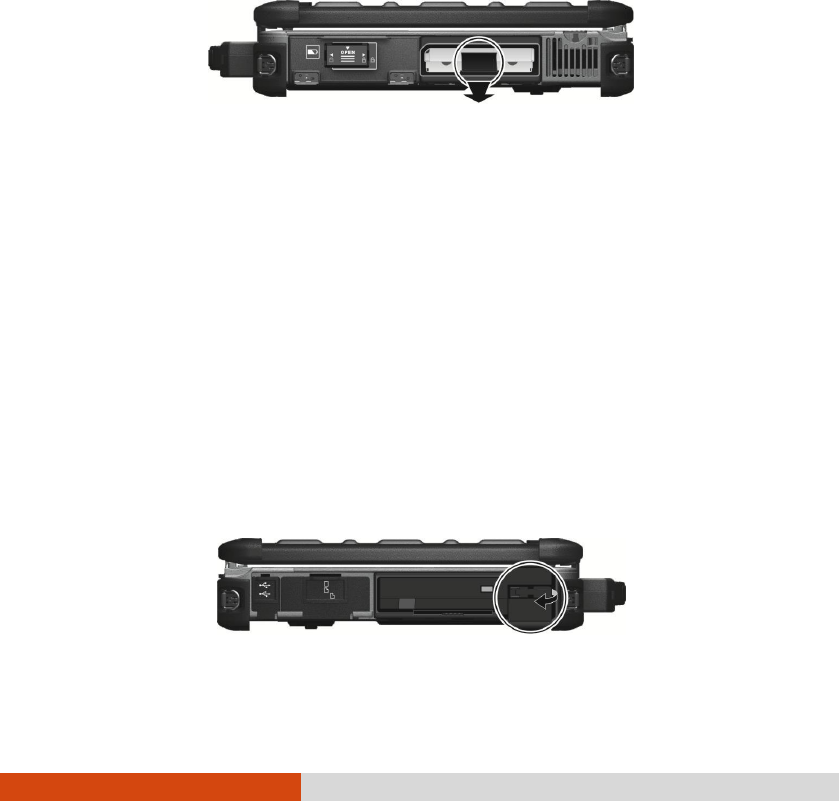
53
Changing or Replacing
Replacing the Hard Disk Drive
1. Turn off the computer and disconnect the AC adapter.
2. Locate the hard disk drive on the right side of your computer and open the
protective cover.
3. Pull the strip and slide the hard disk drive out of the slot.
4. With the strip facing outward, insert the new hard disk drive all the way into
the slot.
5. Close the cover.
Installing a Secondary Battery Pack or Hard Disk
Drive
You can purchase a secondary battery pack or hard disk drive to be installed in
the multi-purpose device bay.
1. Locate the multi-purpose device bay on the left side of your computer and open
the protective cover.
2. Pull the strip and slide the existing device out of the bay.
3. With the strip facing outward, insert the new device all the way into the bay.
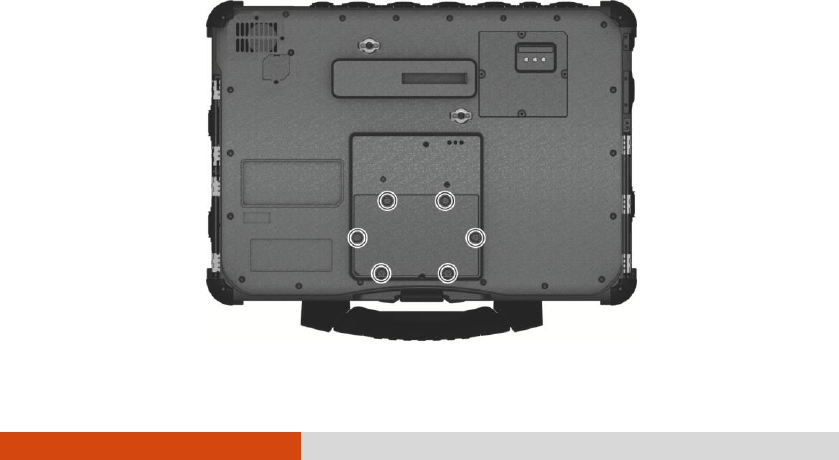
54
4. Close the cover.
System Memory Upgrade
You can upgrade your computer by expanding system memory.
CAUTION:
It is not recommended that you buy and install RAM modules
by yourself. If you want to expand system memory, please ask
Getac service center to install DRAM modules for you so that
full compatibility can be guaranteed.
RAM modules are extremely sensitive to static electricity.
There are cases where static electricity generated by the
human body has adversely affected such modules. When
inserting or removing a RAM module, do not touch the
terminals or internal components, insert objects other than
the module, or allow foreign particles to enter. Doing so
has been known to cause damage, fire, or electrical shock.
To install the RAM module:
1. Disconnect the AC adapter and remove the battery pack.
2. Carefully place the computer upside down.
3. Remove the 6 screws to open the compartment cover.
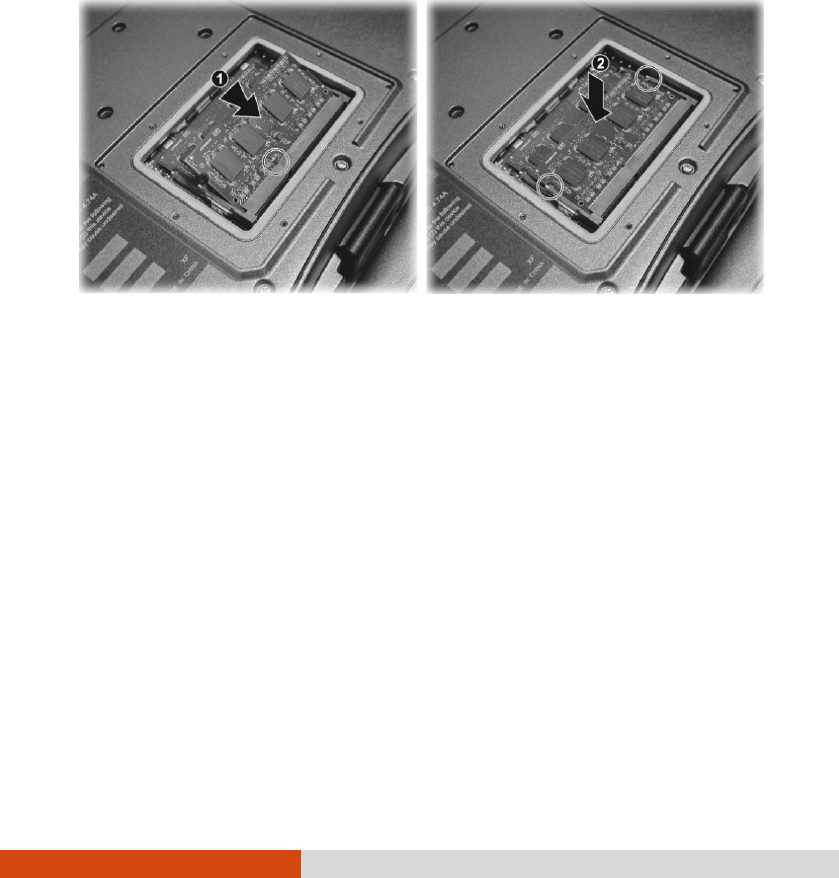
55
4. To install the RAM module, match the module's notched part with the socket's
projected part and firmly insert the module into the socket at a 20-degree angle
().
Then push down until the retaining clips lock the module into position
().
CAUTION: If the RAM module is difficult to insert or difficult
to push down, do not force it. Check once more to ensure that
the module is positioned correctly.
5. Replace the compartment cover and secure with 6 screws.
6. Replace the battery pack.

56
Chapter 5
Chapter 5 Using BIOS Setup
BIOS Setup Utility is a program for configuring the BIOS (Basic Input/ Output
System) settings of the computer. BIOS is a layer of software, called firmware, that
translates instructions from other layers of software into instructions that the computer
hardware can understand. The BIOS settings are needed by your computer to identify
the types of installed devices and establish special features.
This chapter tells you how to use the BIOS Setup Utility.

57
When and How to Use
You need to run BIOS Setup Utility when:
You see an error message on the screen requesting you to run BIOS Setup
Utility.
You want to restore the factory default BIOS settings.
You want to modify some specific settings according to the hardware.
You want to modify some specific settings to optimize the system performance.
To run BIOS Setup Utility, click Settings Update & security Recovery.
Under Advanced startup, click Restart now. In the boot options menu, click
Troubleshoot Advanced options UEFI Firmware Settings. Click Restart.
In general, you can use the arrow keys to move around and + / – keys to change
the setup values. Keyboard information can be found at the bottom of the screen.
NOTE: The actual setting items on your model may differ from
those described in this chapter.

58
Menu Descriptions
Information Menu
The Information menu contains the basic configuration information of the system.
There are no user-definable items in this menu.
NOTE: The “Asset Tag” information appears when you have entered
the asset number for this computer using the asset management
program. The program is provided in the Asset tag folder of the
Driver disc.
Main Menu
The Main menu contains the various system settings.
System Date sets the system date.
System Time sets the system time.
OS Select specifies which version of Windows your computer is running.
Boot Priority determines the first device that the system boots from. Select Legacy
First or UEFI First according to your needs.
Legacy USB Support enables or disables the system’s support for Legacy USB
device in DOS mode
CSM Support enables or disables CSM (Compatibility Support Mode). You can
set this item to Yes for backward compatibility with legacy BIOS services.
PXE Boot sets the PXE boot to
UEFI
or
Legacy
. PXE (Preboot eXecution
Environment) is an environment to boot computers using a network interface
independently of data storage devices or installed operating systems.
Internal Numlock sets if the Num Lock function of the built-in keyboard can
work. When set to Enabled, you can press Fn + Num LK to activate the numeric
keypad, which is embedded in the typewriter keys. When set to Disabled, Num

59
Lock does not work. In this case, you can still press Fn + a letter key to enter
a number.
Advanced Menu
The Advanced menu contains the advanced settings.
Wake Up Capability
Any-key Wake Up from S3 allows any key to wake up the system from S3 (Sleep)
state.
USB Wake Up From S3 allow a USB device activity to wake up the system from
S3 (Sleep) state.
System Policy allows you to choose between Performance and
Balance
. If battery
life is your first priority, select
Balance
. If you need system performance more
than battery life, select
Performance
.
AC Initiation sets if connecting AC power will automatically start or resume the
system.
SATA Mode Selection determines how the SATA controller works. It can be set
to either
AHCI
or
Intel RST Premium
(RAID) mode
.
CAUTION: Incorrect SATA mode settings can result in hard disk
drive boot failure.
Active Management Technology Support (This item appears only on models
supporting vPro.)
Intel AMT Support enables or disables Intel® Active Management Technology BIOS
extension execution. AMT allows the system administrator to access an AMT
featured computer remotely.
Intel AMT Setup Prompt determines whether the prompt for entering Intel AMT
Setup appears or not during POST. (This item only appears when the previous
item is set to Enabled.)
USB Provisioning of AMT enables or disables the use of a USB key for provisioning
Intel AMT.
Virtualization Technology Setup
Intel(R) Virtualization Technology enables or disables Intel® VT (Intel
Virtualization Technology) feature which provides hardware support for processor
virtualization. When enabled, a VMM (Virtual Machine Monitor) can utilize the

60
additional hardware virtualization capabilities provided by this technology.
Intel(R) VT for Directed I/O (VT-d) enables or disables VT-d (Intel® Virtualization
Technology for Directed I/O). When enabled, VT-d helps enhance Intel platforms
for efficient virtualization of I/O devices.
SW Guard Extensions (SGX) can be set to
Disabled
,
Enabled
, or
Software
Controlled
.
Intel® Software Guard Extensions (Intel® SGX) is an Intel technology
for increasing the security of application code. It is used by application developers.
Graphics Setup
DVMT Pre-Allocated sets the amount of pre-allocated (fixed) graphics memory
for use by the internal graphics device.
Device Configuration enables or disables several hardware components. The
items available for setting depend on your model.
Diagnostics and System Tester
H2ODST Tool performs system baseline check.
Device Manager allows you to manage RAID volumes on the Intel RAID controller
and Adaptec 6805 RAID card controller (if existing on your system). Note that
the Intel RAID controller is available only when you set the SATA Mode Selection
item to
Intel RST Premium
.
Security Menu
The Security menu contains the security settings, which safeguard your system against
unauthorized use.
NOTE:
You can set the user password only when the supervisor
password has been set.
If both the administrator and user passwords are set, you can
enter any of them for starting up the system and/or entering
BIOS Setup. However, the user password only allows you to
view/change the settings of certain items.

61
Set Supervisor/User Password sets the supervisor/user password. You can set
the supervisor/user password to be required for starting up the system and/or
entering BIOS Setup.
Strong Password enables or disables strong password. When enabled, the
password you set must contain at least one upper-case letter, one lower-case
letter, and one digit.
Password Configuration sets the minimum password length. Enter the number in
the input field and select [Yes]. The number should be between 4 and 64.
Password on Boot allows you to enable or disable the entering of password for
booting up your system.
Set HDD 0 Password sets the password for locking the Primary Master hard disk
drive. After setting a password, the hard disk drive can only be unlocked by
the password no matter where it is installed.
TPM Setup Menu
TPM Support enables or disables TPM (Trusted Platform Module) support. TPM
(Trusted Platform Module) is a component on your computer’s mainboard that
is specifically designed to enhance platform security by providing a protected
space for key operations and other security critical tasks.
Change TPM State allows you to select between No Change and Clear.
Intel Trusted Execution Technology enables utilization of additional hardware
capabilities provided by Intel® Trusted Execution Technology.
Boot Menu
The Boot menu sets the sequence of the devices to be searched for the operating
system. (See the information on the right side of the menu for keyboard usage.)
Exit Menu
The Exit menu displays ways of exiting BIOS Setup Utility. After finishing with your
settings, you must save and exit so that the changes can take effect.

62
Exit Saving Changes saves the changes you have made and exits BIOS Setup
Utility.
Exit Discarding Changes exits BIOS Setup Utility without saving the changes you
have made.
Load Setup Defaults loads the factory default values for all the items.
Discard Changes restores the previous values for all the items.
Saves Changes saves the changes you have made.

63
Chapter 6
Chapter 6 Using Getac Software
Getac software includes application programs for specific computer components and
utility programs for overall management.
This chapter briefly introduces the programs.
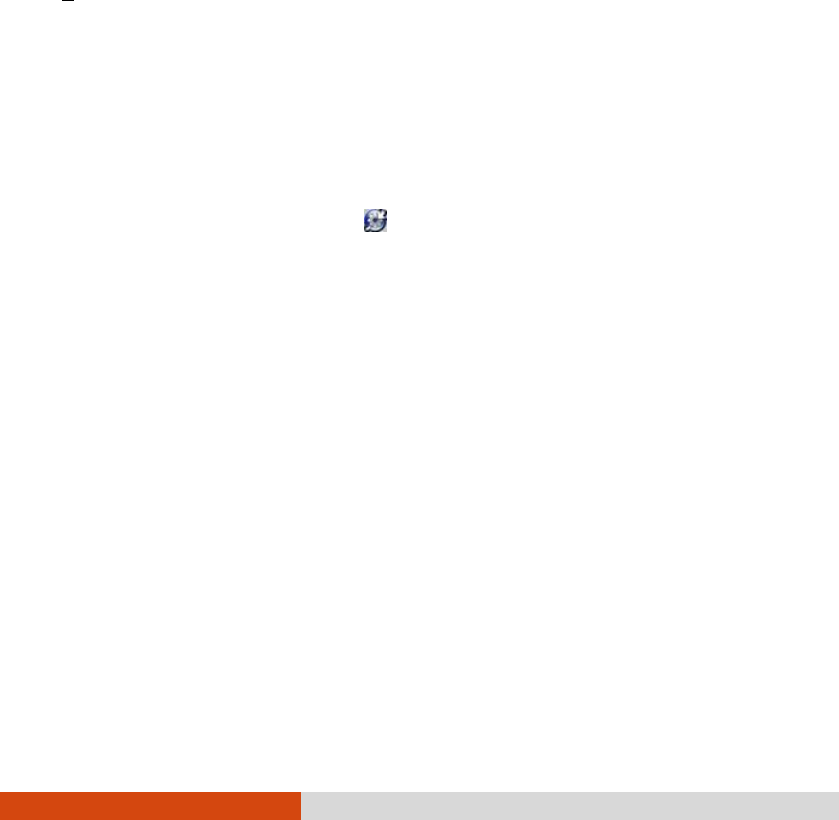
64
G-Manager
G-Manager is a unified user interface utility that allows you to view, manage, or
configure your computer features. With G-Manager, you can perform all or some
of the tasks listed below.
View system information.
Check the battery status and configure the battery.
Configure ECO modes (or called power profiles).
Configure how the light sensor works.
Change the function of the hardware button.
Monitor the system.
View the GPS information (select models only).
Right-click the Getac Utility icon located on Windows taskbar and select
G-Manager to start the program. The G-Manager window appears, containing several
tabs.
NOTE: Depending on your model, the actual items and information
appearing on the screen may differ from those shown in this
manual.
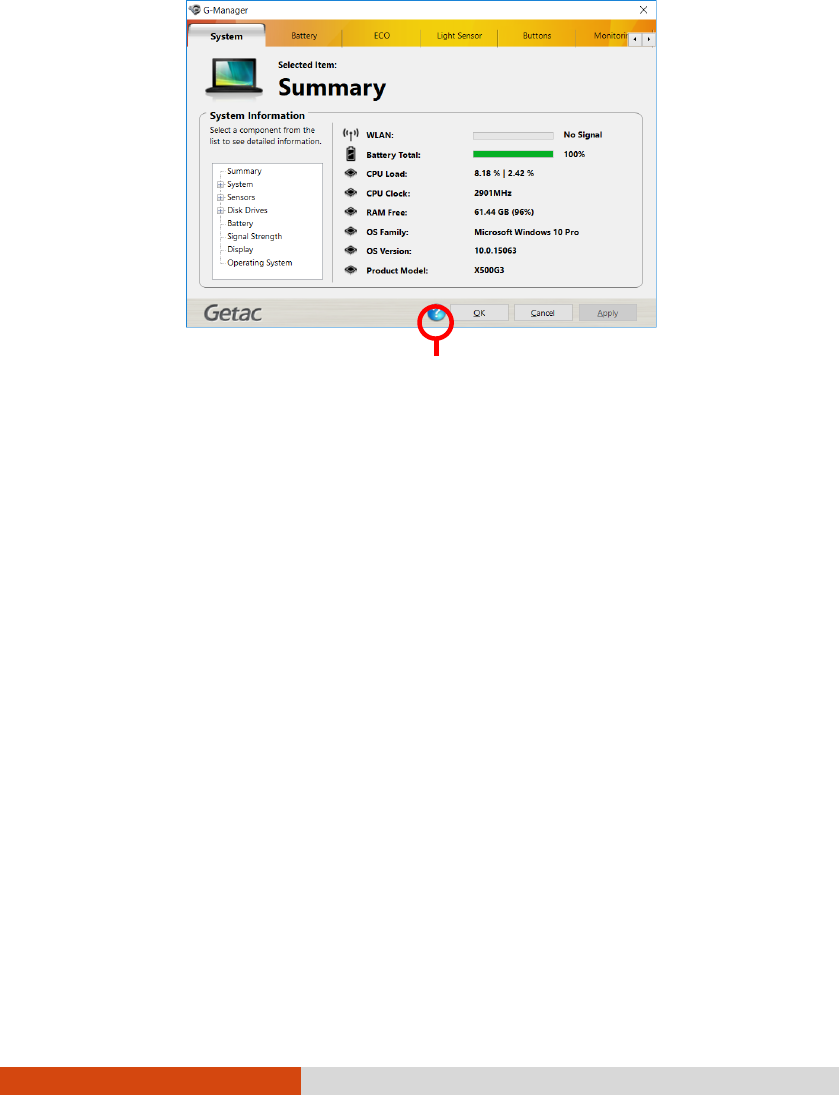
65
For detailed information on the program, see the program’s online help.
Help

66
Chapter 7
Chapter 7 Care and Maintenance
Taking good care of your computer will ensure a trouble-free operation and reduce
the risk of damage to your computer.
This chapter gives you guidelines covering areas such as protecting, storing, cleaning,
and traveling.

67
Protecting the Computer
To safeguard the integrity of your computer data as well as the computer itself,
you can protect the computer in several ways as described in this section.
Using an Anti-Virus Strategy
You can install a virus-detecting program to monitor potential viruses that could
damage your files.
Using the Cable Lock
You can use a Kensington-type cable lock to protect your computer against theft.
The cable lock is available in most computer stores.
To use the lock, loop the lock cable around a stationary object such as a table.
Insert the lock to the Kensington lock hole and turn the key to secure the lock.
Store the key in a safe place.
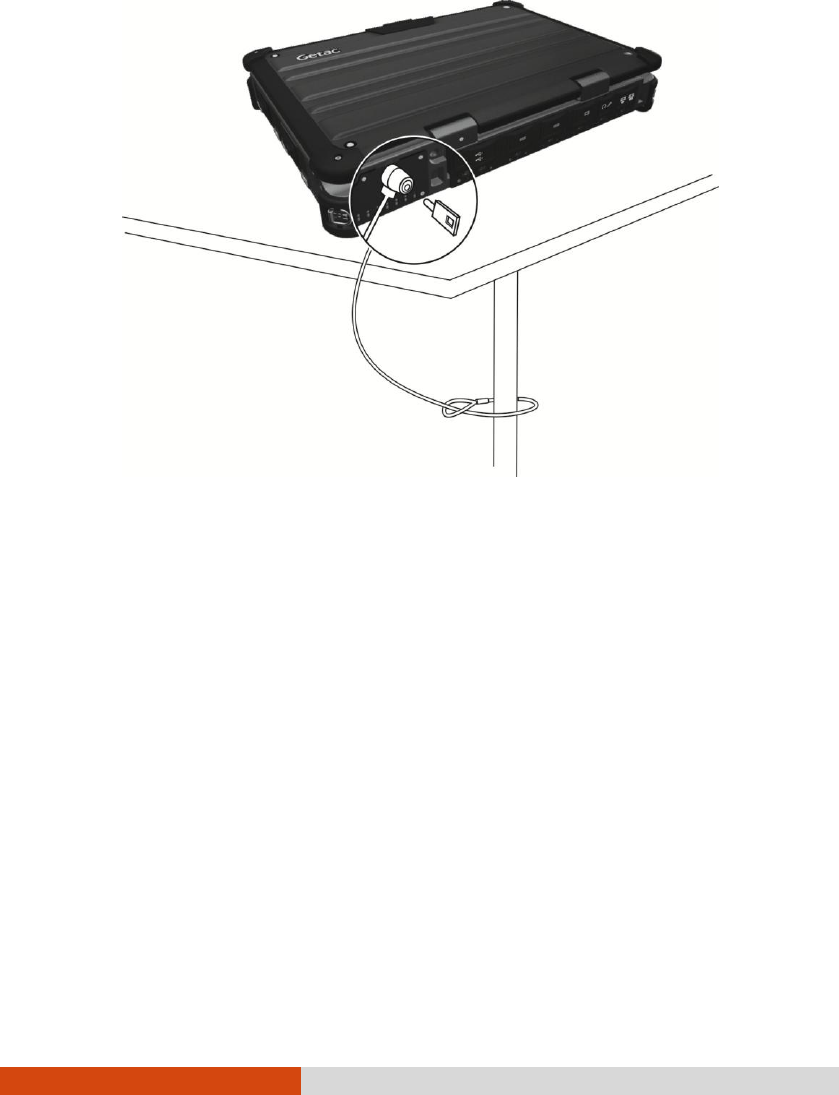
68

69
Taking Care of the Computer
Location Guidelines
For optimal performance, use the computer where the recommended temperature
is between 0 C (32 F) and 55 C (131 F). (Actual operating temperature
depends on product specifications.)
Avoid placing the computer in a location subject to high humidity, extreme
temperatures, mechanical vibration, direct sunlight, or heavy dust. Using the
computer in extreme environments for long periods can result in product
deterioration and a shortened product life.
Operating in an environment with metallic dust is not allowed.
Place the computer on a flat and steady surface. Do not stand the computer
on its side or store it in an upside-down position. A strong impact by dropping
or hitting may damage the computer.
Do not cover or block any ventilation openings on the computer. For example,
do not place the computer on a bed, sofa, rug, or other similar surface.
Otherwise, overheating may occur that results in damage to the computer.
As the computer can become very hot during operation, keep it away from objects
that are vulnerable to heat.
Keep the computer at least 13 cm (5 inches) away from electrical appliances
that can generate a strong magnetic field such as a TV, refrigerator, motor,
or a large audio speaker.
Avoid moving the computer abruptly from a cold to a warm place. A temperature
difference of more than 10 C (18 F) may cause condensation inside the unit,
which may damage the storage media.
General Guidelines
Do not place heavy objects on top of the computer when it is closed as this
may damage the display.

70
Do not move the computer simply by grasping the display screen.
The screen surface is easily scratched. Do not use paper towels to clean the
display but use the included soft cloth.
LCD image sticking occurs when a fixed pattern is displayed on the screen for
a prolonged period of time. You can avoid the problem by limiting the amount
of static content on the display. It is recommended that you use a screen saver
or turn off the display when it is not in use.
To maximize the life of the backlight in the display, allow the backlight to
automatically turn off as a result of power management.
Cleaning Guidelines
Never clean the computer with its power on.
Use a soft cloth moistened with water or a non-alkaline detergent to wipe the
exterior of the computer.
Gently wipe the display with a soft, lint-free cloth.
Dust or grease on the touchpad can affect its sensitivity. Clean the pad by
using adhesive tape to remove the dust and grease on its surface.
If water or liquid is split onto the computer, wipe it dry and clean when possible.
Though your computer is water-proof, do not leave the computer wet when you
can dry it.
If the computer gets wet where the temperature is 0C (32F) or below, freeze
damage may occur. Make sure to dry the wet computer.
Battery Pack Guidelines
Recharge the battery pack when it is nearly discharged. When recharging, make
sure that the battery pack is fully charged. Doing so may avoid harm to the
battery pack.

71
The battery pack is a consumable product and the following conditions will shorten
its life:
– when frequently charging the battery pack
– when using, charging, or storing in high temperature condition
To avoid hastening the deterioration of the battery pack thereby prolonging its
useful life, minimize the number of times you charge it so as not to frequently
increase its internal temperature.
Charge the battery pack between 10 C ~ 30 C (50 F ~ 86 F) temperature
range. A higher environment temperature will cause the battery pack’s temperature
to rise. Avoid charging the battery pack inside a closed vehicle and in hot weather
condition. Also, charging will not start if the battery pack is not within the allowed
temperature range.
It is recommended that you do not charge the battery pack more than once
a day.
It is recommended that you charge the battery pack with the computer’s power
off.
To maintain the battery pack’s operating efficiency, store it in a cool dark place
removed from the computer and with 30 % ~ 40 % charge remaining.
Important guidelines when using the battery pack.
When installing or removing the battery pack take note of the following:
– avoid installing or removing the battery pack when the computer is in
Sleep mode. Abruptly removing the battery pack may cause loss of
data or the computer may become unstable.
– avoid touching the battery pack terminals or damage may occur,
thereby causing improper operation to it or the computer.
The computer’s input voltage and surrounding temperature will directly affect the
battery pack’s charge and discharge time:
– charging time will be prolonged when the computer is turned on.
To shorten the charging time, it is recommended that you place the
computer in sleep or hibernation mode.
– a low temperature will prolong the charging time as well as hasten
the discharge time.

72
When using battery power in an extremely low temperature environment, you may
experience shortened operating time and incorrect battery level reading. This
phenomenon comes from the chemical characteristics of batteries. The appropriate
operating temperature for the battery is -10 C ~ 50 C (14 F ~ 122 F).
Do not leave the battery pack in storage for more than six months without
recharging it.
Touchscreen Guidelines
Use the finger or stylus on the display. Using a sharp or metallic object other
than your finger or stylus may cause scratches and damage the display, thereby
causing errors.
Use a soft cloth to remove dirt on the display. The touchscreen surface has
a special protective coating that prevents dirt from sticking to it. Not using a
soft cloth may cause damage to the special protective coating on the touchscreen
surface.
Turn off the computer power when cleaning the display. Cleaning the display
with the power on may cause improper operation.
Do not use excessive force on the display. Avoid placing objects on top of the
display as this may cause the glass to break thereby damaging the display.
Using the touchscreen during low temperature (below 5 oC / 41 F) may
cause a slower response time, this is normal. A normal response time may
be restored upon returning to room temperature.
When there is noticeable discrepancy in the operation of the touchscreen function
(wrong location on intended operation or improper display resolution), refer to
the Windows online Help for instructions on recalibrating the touchscreen display.

73
When Traveling
Before traveling with your computer, make a backup of your hard disk data into
flash disks or other storage devices. As an added precaution, bring along an
extra copy of your important data.
Make sure that the battery pack is fully charged.
Make sure that the computer is turned off and the top cover is securely closed.
Make sure that all the connector covers are closed completely to ensure the
waterproof integrity.
Do not leave objects in between the keyboard and closed display.
Disconnect the AC adapter from the computer and take it with you. Use the
AC adapter as the power source and as a battery-charger.
Hand-carry the computer. Do not check it in as luggage.
If you need to leave the computer in the car, put it in the trunk of the car
to avoid exposing the computer to excessive heat.
When going through airport security, it is recommended that you send the
computer and flash disks through the X-ray machine (the device you set your
bags on). Avoid the magnetic detector (the device you walk through) or the
magnetic wand (the handheld device used by security personnel).
If you plan to travel abroad with your computer, consult your dealer for the
appropriate AC power cord for use in your country of destination.

74
Chapter 8
Chapter 8 Troubleshooting
Computer problems can be caused by hardware, software, or both. When you
encounter any problem, it might be a typical problem that can easily be solved.
This chapter tells you what actions to take when solving common computer problems.

75
Preliminary Checklist
Here are helpful hints to follow before you take further actions when you encounter
any problem:
Try to isolate which part of the computer is causing the problem.
Make sure that you turn on all peripheral devices before turning on the computer.
If an external device has a problem, make sure that the cable connections are
correct and secure.
Make sure that the configuration information is properly set in the BIOS Setup
program.
Make sure that all the device drivers are correctly installed.
Make notes of your observations. Are there any messages on the screen? Do
any indicators light? Do you hear any beeps? Detailed descriptions are useful
to the service personnel when you need to consult one for assistance.
If any problem persists after you follow the instructions in this chapter, contact an
authorized dealer for help.

76
Solving Common Problems
Battery Problems
The battery does not charge (Battery Charge indicator does not light amber).
Make sure that the AC adapter is properly connected.
Make sure that the battery is not too hot or cold. Allow time for the battery
pack to return to room temperature.
If the battery doesn't charge after it has been stored in very low temperatures,
try disconnecting and reconnecting the AC adapter to solve the problem.
Make sure that the battery pack is installed correctly.
Make sure that the battery terminals are clean.
The operating time of a fully charged battery becomes shorter.
If you often partially recharge and discharge, the battery might not be charged
to its full potential. Initialize the battery to solve the problem.
The battery operating time indicated by the battery meter does not match the
actual operating time.
The actual operating time can be different from the estimated time, depending
on how you are using the computer. If the actual operating time is much less
than the estimated time, initialize the battery.
Bluetooth Problems
I cannot connect to another Bluetooth-enabled device.
Make sure that both devices have activated Bluetooth feature.
Make sure that the distance between the two devices is within the limit and
that there are no walls or other obstructions between the devices.
Make sure that the other device is not in “Hidden” mode.

77
Make sure that both devices are compatible.
Display Problems
Nothing appears on the screen.
During operation, the screen may automatically turn off as a result of power
management. Press any key to see if the screen comes back.
The brightness level might be too low. Increase brightness.
The display output might be set to an external device. To switch the display
back to the LCD, press the Fn+F9 hot key or change the display through the
Display Settings Properties.
The characters on the screen are dim.
Adjust the brightness and/or contrast.
The display brightness cannot be increased.
As a protection, the display brightness will be fixed at a low level when the
surrounding temperature is too high or too low. It is not a malfunction in this
situation.
Bad dots appear on the display at all times.
A small number of missing, discolored, or bright dots on the screen are an
intrinsic characteristic of TFT LCD technology. It is not regarded as a LCD defect.
Clouding (or called “mura”) happens on the screen when you exert forces on
the left or right side of the LCD frame.
This is a normal phenomenon, not a defect.
DVD Drive Problems
The DVD drive cannot read a disc.
Make sure that the disc is correctly seated in the tray, with the label facing
up.
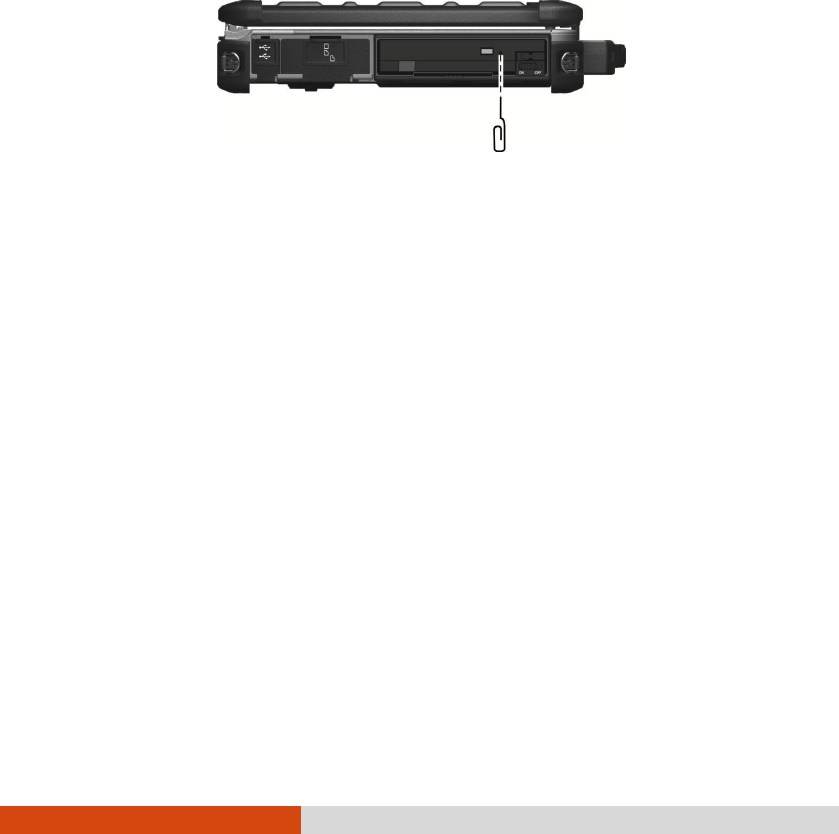
78
Make sure that the disc is not dirty. Clean the disc with a disc cleaning kit,
available in most computer stores.
Make sure that the computer supports the disc or the files contained.
You cannot eject a disc.
The disc is not properly seated in the drive. Manually release the disc by inserting
a small rod, such as a straightened paperclip, into the drive’s manual eject
hole and pushing firmly to release the tray.
Hardware Device Problems
The computer does not recognize a newly installed device.
The device may not be correctly configured in the BIOS Setup program. Run
the BIOS Setup program to identify the new type.
Make sure if any device driver needs to be installed. (Refer to the documentation
that came with the device.)
Make sure if the device needs any jumper or switch settings. (Refer to the
documentation that came with the device.)
Check the cables or power cords for correct connections.
For an external device that has its own power switch, make sure that the power
is turned on.
Hard Disk Drive Problems
The hard disk drive error message appears on the screen.
The hard disk drive has defects. Ask your dealer for help.

79
The hard disk drive operations seem slow.
The data files stored on the hard disk drive may be fragmented. Defragment
the drive. (See Windows online help for instructions.).
The hard disk drive in-use indicator glows without blinking.
The data files stored on the hard disk drive may be fragmented. Defragment
the drive. (See Windows online help for instructions.).
Keyboard and Touchpad Problems
The keyboard does not respond.
Try connecting an external keyboard. If it works, contact an authorized dealer,
as the internal keyboard cable might be loose.
Water or liquid is spilt into the keyboard.
Immediately turn off the computer and unplug the AC adapter. Then tilt the
keyboard 90 degrees to the right (where the drainpipe ends are located) to
let the liquid flow out of the keyboard. Make sure to clean up any part of the
spill you can get to. Though the keyboard of your computer is spill-proof, liquid
will remain in the keyboard enclosure if you don’t remove it. Wait for the keyboard
to air dry before using the computer again.
The touchpad does not work, or the pointer is difficult to control with the
touchpad.
Make sure that the touchpad is clean.
LAN Problems
I cannot access the network.
Make sure that the LAN cable is properly connected to the RJ-45 connector
and the network hub.
Make sure that the network configuration is appropriate.
Make sure that the user name or password is correct.

80
Power Management Problems
The computer does not enter Sleep or Hibernation mode automatically.
If you have a connection to another computer, the computer does not enter
Sleep or Hibernation mode if the connection is actively in use.
Make sure that the Sleep or Hibernation time-out is enabled.
The computer does not enter Sleep or Hibernation mode immediately.
If the computer is performing an operation, it normally waits for the operation
to finish.
The computer does not resume from Sleep or Hibernation mode.
The computer automatically enters Sleep or Hibernation mode when the battery
pack is empty. Do any one of the following:
Connect the AC adapter to the computer.
Replace the empty battery pack with a fully charged one.
Software Problems
An application program does not work correctly.
Make sure that the software is correctly installed.
If an error message appears on the screen, consult the software program’s
documentation for further information.
If you are sure the operation has stop, reset the computer.
Sound Problems
No sound is produced.
Make sure that the volume control is not set too low.
Make sure that the computer is not in Sleep mode.
If using an external speaker, make sure that the speaker is properly connected.
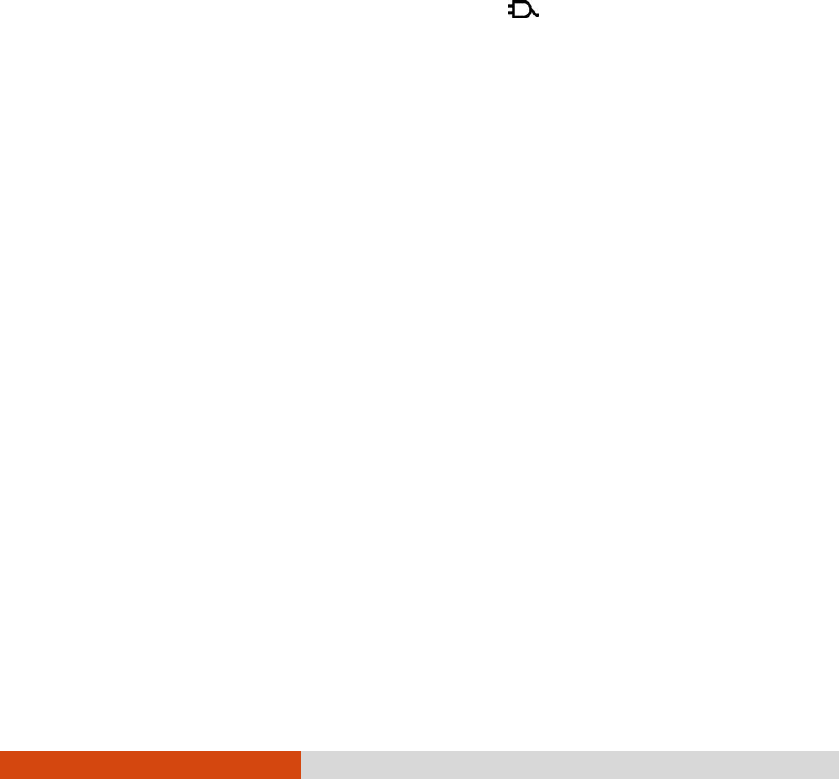
81
Distorted sound is produced.
Make sure that the volume control is not set too high or too low. In most cases,
a high setting can cause the audio electronics to distort the sound.
Startup Problems
When you turn on the computer, it does not seem to respond.
Make sure that either the AC adapter is connected or the battery has power.
For models with the “HDD preheat” feature: When turning on the computer in an
extremely low temperature environment, the computer will heat up the hard disk
before starting up. The AC Power indicator ( ) lights red to indicate the
heater is on. Wait till the heating is finished. However, if external AC power
is not available and the remaining battery power is too low for the heating to
complete, the computer may not start up. In case the computer fails to start
up, turn off the computer and leave it in room temperature for about an hour
before trying to turn it on again.
WLAN Problems
I cannot use the WLAN feature.
Make sure that the WLAN feature is turned on.
Transmission quality is poor.
Your computer may be in an out-of-range situation. Move your computer closer
to the Access Point or another WLAN device it is associated with.
Check if there is high interference around the environment and solve the problem
as described next.
Radio interference exists.
Move your computer away from the device causing the radio interference such
as microwave oven and large metal objects.

82
Plug your computer into an outlet on a different branch circuit from that used
by the affecting device.
Consult your dealer or an experienced radio technician for help.
I cannot connect to another WLAN device.
Make sure that the WLAN feature is turned on.
Make sure that the SSID setting is the same for every WLAN device in the
network.
Your computer is not recognizing changes. Restart the computer.
Make sure that the IP address or subnet mask setting is correct.
I cannot communicate with the computer in the network when Infrastructure
mode is configured.
Make sure that the Access Point your computer is associated with is powered
on and all the LEDs are working properly.
If the operating radio channel is in poor quality, change the Access Point and
all the wireless station(s) within the BSSID to another radio channel.
Your computer may be in an out-of-range situation. Move your computer closer
to the Access Point it is associated with.
Make sure that your computer is configured with the same security option
(encryption) to the Access Point.
Use the Web Manager/Telnet of the Access Point to check whether it is connected
to the network.
Reconfigure and reset the Access Point.
I cannot access the network.
Make sure that the network configuration is appropriate.
Make sure that the user name or password is correct.
You have moved out of range of the network.

83
Turn off power management.
Other Problems
The date/time is incorrect.
Correct the date and time via the operating system or BIOS Setup program.
After you have performed everything as described above and still have the
incorrect date and time every time you turn on the computer, the RTC
(Real-Time Clock) battery is at the end of its life. Call an authorized dealer
to replace the RTC battery.

84
Resetting the Computer
You may have to reset (reboot) your computer on some occasions when an error
occurs and the program you are using hangs up.
If you are sure the operation has stopped and you cannot use the “restart” function
of the operating system, reset the computer
Reset the computer by any of these methods:
Press Ctrl+Alt+Del on the keyboard. This opens the Ctrl-Alt-Del screen where
you can select actions including Restart.
If the above action does not work, press and hold the power button for more
than 5 seconds to force the system to turn off. Then turn on the power again.

85
System Restore, Recovery, or Reset
Click Settings Update & security. You have several options.
System Restore
This option allows you to restore Windows to an earlier point in time if you
have created a restore point.
Recover from a drive
If you have created a recovery drive on Windows 10, you can use the recovery
drive to reinstall Windows
Reset this PC
This option allows you to reinstall Windows with or without keeping your files.
See Microsoft website for more information.
NOTE: System recovery for Windows 10 typically will take several
hours to complete.

86
Using the Driver Disc (Optional)
NOTE: You can download the latest drivers and utilities from
Getac website at http://www.getac.com Support.
The Driver disc contains drivers and utilities required for specific hardware in your
computer.
Since your computer comes with drivers and utilities pre-installed, you normally do
not need to use the Driver disc. In case you want to manually install Windows,
you will have to install the drivers and utilities one by one after installing Windows.
To manually install drivers and utilities:
1. Start up the computer.
2. Insert the Driver disc. Make sure you use the disc that matches the Windows
version of your computer.
3. The autorun program should automatically start. You will see the installation menu.
Click NEXT to go to the next page if there is more than one.
4. To install a driver or utility, just click the particular button and follow the onscreen
instructions to complete the installation.
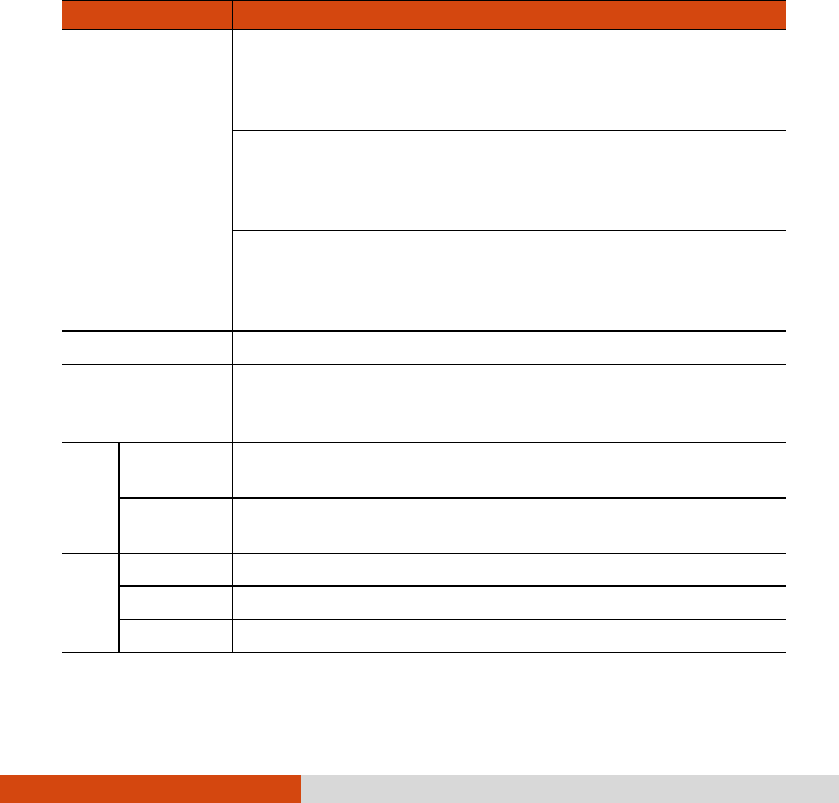
87
Appendix A
Appendix A Specifications
NOTE: Specifications are subject to change without any prior
notice.
Parts
Specifications
CPU
Intel® Core™ i5-7440HQ vPro™ Processor 2.8 GHz, Max 3.8 GHz with Intel®
Turbo Boost Technology
- 6 MB Intel® Smart Cache
- Mobile Intel® QM175 Chipset
Intel® Core™ i7-7820HQ vPro™ Processor 2.9 GHz, Max 3.9 GHz with Intel®
Turbo Boost Technology
- 8 MB Intel® Smart Cache
- Mobile Intel® QM175 Chipset
Intel® Xeon® E3-1505M v6 vPro™ Processor 3.0 GHz, Max 4.0 GHz with
Intel® Turbo Boost Technology
- 8 MB Intel® Smart Cache
- Mobile Intel® CM238 Chipset
BIOS
16 MB SPI Flash
RAM
Default 8 GB (for Intel Core processors) or 16 GB (for Intel Xeon processors),
Max. 64 GB, DDR4 SO-DIMM
Option: ECC DDR4 R-DIMM
Video
Controller
Default: UMA - Intel® HD Graphics 630
Option: Nvidia N16P-GT (Geforce 950M)
Display panel
15.6-inch (16:9) TFT LCD, FHD 1920x1080, sunlight readable, 1200 Nits
maximum brightness, touchscreen with stylus (option)
Audio
Features
Azalia 32 bit, 192KHz chipset, HD audio support, MS-Sound compatible
Speaker
Speaker × 2
Microphone
Integrated microphone
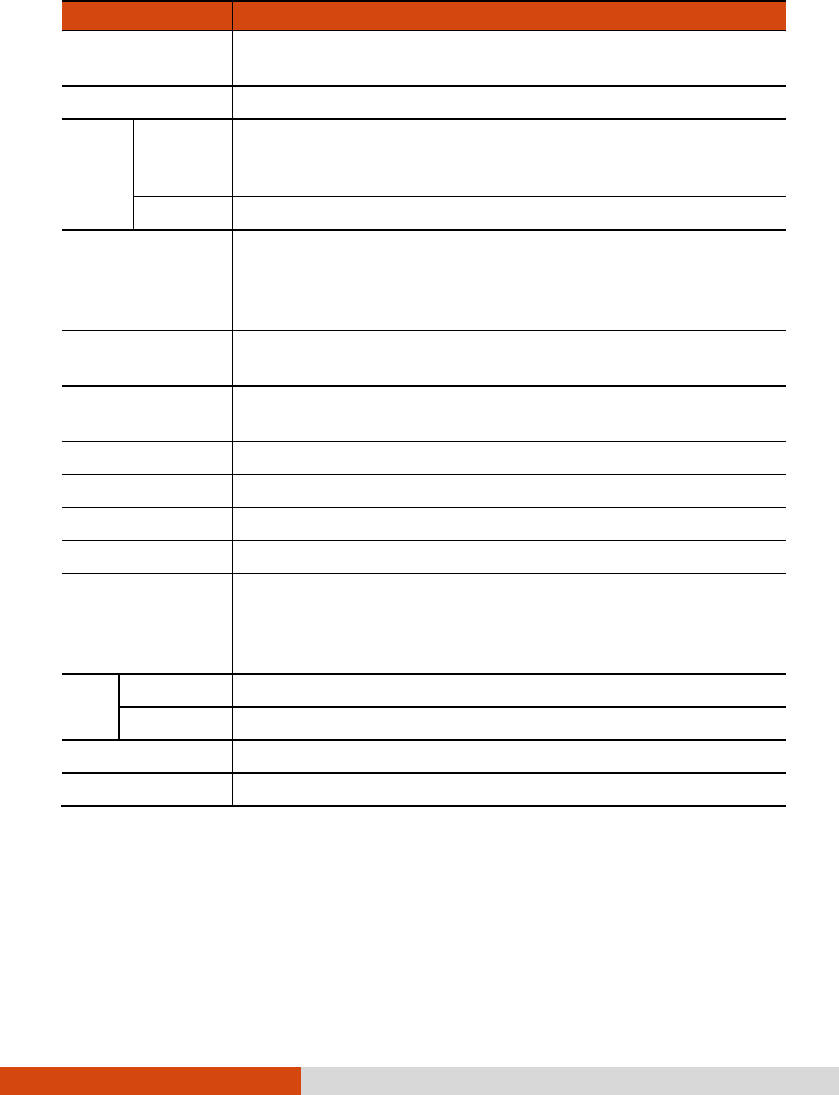
88
Parts
Specifications
Keyboard
Standard keys with numeric pad keys, 12 function keys, special Fn (Function)
key and Windows keys, water-proof membrane, with backlight (option)
Pointing device
Glide touchpad with 2 buttons
Storage
device
Hard disk
drive
SATA III interface, 2.5-inch diameter, shock-mounted, user-removable,
solid-state disk (option), HDD heater (option), secondary hard disk drive
and RAID support (option)
DVD drive
SATA interface, Super-Multi DVD drive
Card slots
PCMCIA CardBus Type II
ExpressCard/54
Smart Card
Secure Digital card
I/O ports
USB 3.0 x 4, serial (RS232/RS422) x 2, VGA, HDMI, RJ-45 x 2, headphone
out, microphone, docking
LAN
LAN1: Intel® Jacksonville LM Gigabit Network Connection
LAN2: Realtek 8111H
WLAN + Bluetooth
Intel (Windstorm Peak 8265) 802.11 AC + Bluetooth 4.2 combo
GPS (option)
GPS module
WWAN (option)
WWAN 3G minicard, external accessible SIM card slot
Camera (option)
2M FHD Webcam
Security
Kensington lock
TPM 2.0
Fingerprint scanner, slide type (option)
Smart Card Reader
Power
AC adapter
Universal AC adapter, 150 W; input: 100240 V, output: 19 V
Battery pack
8700mAH, 9 cells, 10.8V
Dimension (LxW×D)
410 x 290 x 65mm (16.1 × 11.4 × 2.5 inch)
Weight
5.2 kg (11.4 lb)

89
Appendix B
Appendix B Regulatory Information
This appendix provides regulatory statements and safety notices on your computer.
NOTE: Marking labels located on the exterior of your computer
indicate the regulations that your model complies with. Please
check the marking labels and refer to the corresponding
statements in this appendix. Some notices apply to specific
models only.

90
On the Use of the System
Class B Regulations
USA
Federal Communications Commission Radio Frequency Interference Statement
NOTE:
This equipment has been tested and found to comply with the limits for a Class
B digital device pursuant to Part 15 of the FCC Rules. These limits are designed
to provide reasonable protection against harmful interference in a residential installation.
This equipment generates, uses, and can radiate radio frequency energy and, if not
installed and used in accordance with the instructions, may cause harmful interference
to radio communications. However, there is no guarantee that interference will not occur
in a particular installation. If this equipment does cause harmful interference to radio
or television reception, which can be determined by turning the equipment off and
on, the user is encouraged to try to correct the interference by one or more of the
following measures:
Reorient or relocate the receiving antenna.
Increase the separation between the equipment and receiver.
Connect the equipment into an outlet on a circuit different from that to which
the receiver is connected.
Consult the dealer or an experienced radio/TV technician for help.
Any changes or modifications not expressly approved by the manufacturer could void
the user’s authority to operate the equipment.
Please note:
The use of a non-shielded interface cable with this equipment is prohibited.

91
Canada
Canadian Department of Communications
Radio Interference Regulations Class B Compliance Notice
This Class B digital apparatus meets all requirements of the Canada
Interference-Causing equipment regulations.
Cet appareil numérique de Classe B respecte toutes les exigences du Règlement
Canadien sur le matériel brouileur.
This digital apparatus does not exceed the Class B limits for radio noise emissions
from digital apparatus set out in the Radio Interference Regulations of the Canadian
Department of Communications.
Le présent appareil numérique n’émet pas de bruits radioélectriques dépassant les
limites applicables aux appareils numériques de la classe B prescrites dans le
Règlement sur le brouillage radioélectrique édicté par le ministère des Communications
du Canada.
Safety Notices
About the Battery
Keep the battery pack out of the reach of children.
Caution Texts Concerning Lithium Batteries
DANISH
ADVARSEL! Lithiumbatteri – Eksplosionsfare ved fejlagtig håndtering. Udskiftning må
kun ske med batteri af samme fabrikat og type. Levér det brugte batteri tilbage
til leverandøren.
NORWEGIAN
ADVARSEL: Eksplosjonsfare ved feilaktig skifte av batteri. Benytt samme batteritype
eller en tilsvarende type anbefalt av apparatfabrikanten. Brukte batterier kasseres i
henhold til fabrikantens instruksjoner.
SWEDISH
VARNING: Explosionsfara vid felaktigt batteribyte. Använd samma batterityp eller en

92
ekvivalent typ som rekommenderas av apparattillverkaren. Kassera använt batteri enligt
fabrikantens instruktion.
FINNISH
VAROITUS: Paristo voi räjähtää, jos se on virheellisesti asennettu. Vaihda paristo
ainoastaan valmistajan suosittelemaan tyyppiin. Hävitä käytetty paristo valmistajan
ohjeiden mukaisesti.
ENGLISH
CAUTION: Danger of explosion if battery is incorrectly replaced. Replace only with
the same or equivalent type recommended by the equipment manufacturer. Discard
used batteries according to manufacturer's instructions.
DEUTSCH
VORSICHT: Explosionsgefahr bei unsachgemäßem Austausch der Batterie. Ersatz nur
durch denselben oder einen vom Hersteller empfohlenen gleich-wertigen Typ.
Entsorgung gebrauchter Batterien nach Angaben des Herstellers.
FRENCH
ATTENTION: II y a danger d’explosion s’il y a remplacement incorrect de la batterie.
Remplacer uniquement avec une batterie du même type ou d’un type équivalent
recommandé par le constructeur. Mettre au rebut les batteries usagées conformément
aux instructions du fabricant.
Attention (for USA Users)
The product that you have purchased contains a rechargeable battery. The battery
is recyclable. At the end of its useful life, under various state and local laws, it
may be illegal to dispose of this battery into the municipal waste stream. Check
with your local solid waste officials for details in your area for recycling options or
proper disposal.
About the AC Adapter
Use only the AC adapter supplied with your computer. Use of another type of
AC adapter will result in malfunction and/or danger.
Do not use the adapter in a high moisture environment. Never touch the adapter
when your hands or feet are wet.

93
Allow adequate ventilation around the adapter when using it to operate the device
or charge the battery. Do not cover the AC adapter with paper or other objects
that will reduce cooling. Do not use the AC adapter while it is inside a carrying
case.
Connect the adapter to a proper power source. The voltage requirements are
found on the product case and/or packaging.
Do not use the adapter if the cord becomes damaged.
Do not attempt to service the unit. There are no serviceable parts inside. Replace
the unit if it is damaged or exposed to excess moisture.
Option ANSI Instruction
INSTALLATION INSTURCTIONS:
This equipment is suitable for use in Class I, Division 2, Groups A, B, C and
D or non-hazardous locations only.
WARNING – EXPLOSION HAZARD – Do not disconnect equipment unless power
has been removed or the area is known to be non-hazardous.
WARNING – EXPLOSION HAZARD - Substitution of components may impair
suitability for Class I, Division 2.
WARNING - EXPLOSION HAZARD - External Connections/Hubs are not to
be used in a Hazardous Location.
WARNING - EXPLOSION HAZARD - Notebook is to be only powered from
the battery pack while in Hazardous Locations.
Replace battery manufactured by Getac Technology Corp. only. Use of another
battery may present a risk of fire or explosion.

94
On the Use of the RF Device
USA and Canada Safety Requirements and Notices
This device complies with Part 15 of the FCC Rules. Operation is subject to the
following two conditions: (1) This device may not cause harmful interference, and
(2) this device must accept any interference received, including interference that
may cause undesired operation.
This equipment has been tested and found to comply with the limits for a Class
B digital device, pursuant to Part 15 of the FCC Rules. These limits are designed
to provide reasonable protection against harmful interference in a residential
installation. This equipment generates, uses and can radiate radio frequency energy
and, if not installed and used in accordance with the instructions, may cause harmful
interference to radio communications. However, there is no guarantee that interference
will not occur in a particular installation. If this equipment does cause harmful
interference to radio or television reception, which can be determined by turning the
equipment off and on, the user is encouraged to try to correct the interference by
one of the following measures:
Reorient or relocate the receiving antenna.
Increase the separation between the equipment and receiver.
Connect the equipment into an outlet on a circuit different from that to which
the receiver is connected.
Consult the dealer or an experienced radio/TV technician for help.
FCC Caution:
Any changes or modifications not expressly approved by the party responsible
for compliance could void the user's authority to operate this equipment.
This transmitter must not be co-located or operating in conjunction with any
other antenna or transmitter.

95
Radiation Exposure Statement:
This equipment complies with FCC radiation exposure limits set forth for an
uncontrolled environment. This equipment should be installed and operated with
minimum distance 20cm between the radiator & your body.
Note: The country code selection is for non-US model only and is not available
to all US model. Per FCC regulation, all Wi-Fi product marketed in US must fixed
to US operation channels only.
Canada Radio Frequency Interference Requirements
This device complies with Industry Canada license-exempt RSS standard(s).
Operation is subject to the following two conditions:
1) this device may not cause interference, and
2) this device must accept any interference, including interference that may
cause undesired operation of the device.
Le présent appareil est conforme aux CNR d'Industrie Canada applicables aux
appareils radio exempts de licence. L'exploitation est autorisée aux deux
conditions suivantes:
1) l'appareil ne doit pas produire de brouillage, et
l'utilisateur de l'appareil doit accepter tout brouillage radioélectrique subi, même si
le brouillage est susceptible d'en compromettre le fonctionnement.
This Class B digital apparatus complies with Canadian ICES-003.
Cet appareil numérique de la classe B est conforme à la norme NMB-003
du Canada.
This device and its antenna(s) must not be co-located or operating in
conjunction with any other antenna or transmitter, except tested built-in radios.
Cet appareil et son antenne ne doivent pas être situés ou fonctionner en
conjonction avec une autre antenne ou un autre émetteur, exception faites des
radios intégrées qui ont été testées.
The County Code Selection feature is disabled for products marketed in the
US/ Canada.

96
La fonction de sélection de l'indicatif du pays est désactivée pour les produits
commercialisés aux États-Unis et au Canada.
Radiation Exposure Statement:
The product comply with the Canada portable RF exposure limit set forth for an
uncontrolled environment and are safe for intended operation as described in this
manual. The further RF exposure reduction can be achieved if the product can be
kept as far as possible from the user body or set the device to lower output power
if such function is available.
Déclaration d'exposition aux radiations:
Le produit est conforme aux limites d'exposition pour les appareils portables RF pour
les Etats-Unis et le Canada établies pour un environnement non contrôlé.
Le produit est sûr pour un fonctionnement tel que décrit dans ce manuel. La réduction
aux expositions RF peut être augmentée si l'appareil peut être conservé aussi loin
que possible du corps de l'utilisateur ou que le dispositif est réglé sur la puissance
de sortie la plus faible si une telle fonction est disponible.
Caution :
1) the device for operation in the band 5150-5250 MHz is only for indoor use
to reduce the potential for harmful interference to co-channel mobile satellite
systems;
2) the maximum antenna gain permitted for devices in the bands 5250-5350
MHz and 5470-5725 MHz shall comply with the e.i.r.p. limit; and
3) the maximum antenna gain permitted for devices in the band 5725-5825 MHz
shall comply with the e.i.r.p. limits specified for point-to-point and non
point-to-point operation as appropriate.
4) the worst-case tilt angle(s) necessary to remain compliant with the e.i.r.p.
elevation mask requirement set forth in Section 6.2.2(3) shall be clearly
indicated.
5) Users should also be advised that high-power radars are allocated as primary
users (i.e. priority users) of the bands 5250-5350 MHz and 5650-5850
MHz and that these radars could cause interference and/or damage to LE-LAN
devices.

97
Avertissement:
1) les dispositifs fonctionnant dans la bande 5150-5250 MHz sont réservés
uniquement pour une utilisation à l’intérieur afin de réduire les risques de
brouillage préjudiciable aux systèmes de satellites mobiles utilisant les mêmes
canaux;
2) le gain maximal d’antenne permis pour les dispositifs utilisant les bandes
5250-5350 MHz et 5470-5725 MHz doit se conformer à la limite de p.i.r.e.;
3) le gain maximal d’antenne permis (pour les dispositifs utilisant la bande
5725-5825 MHz) doit se conformer à la limite de p.i.r.e. spécifiée pour
l’exploitation point à point et non point à point, selon le cas.
4) les pires angles d’inclinaison nécessaires pour rester conforme à l’exigence
de la p.i.r.e. applicable au masque d’élévation, et énoncée à la section 6.2.2
3), doivent être clairement indiqués.
5) De plus, les utilisateurs devraient aussi être avisés que les utilisateurs de radars
de haute puissance sont désignés utilisateurs principaux (c.-à-d., qu’ils ont
la priorité) pour les bandes 5250-5350 MHz et 5650-5850 MHz et que
ces radars pourraient causer du brouillage et/ou des dommages aux dispositifs
LAN-EL.
European Union CE Marking and Compliance
Notices
Statements of Compliance
English
This product follows the provisions of the European Directive 2014/53/EU.
Danish
Dette produkt er i overensstemmelse med det europæ iske direktiv 2014/53/EU.
Dutch
Dit product is in navolging van de bepalingen van Europees Directief 2014/53/EU.
Finnish
Tämä tuote noudattaa EU-direktiivin 2014/53/EU määräyksiä.

98
French
Ce produit est conforme aux exigences de la Directive Européenne 2014/53/EU.
German
Dieses Produkt entspricht den Bestimmungen der Europäischen Richtlinie
2014/53/EU.
Greek
To προϊόν αυτό πληροί τις προβλέψεις της Ευρωπαϊκής Οδηγίας
2014/53/EU.
Icelandic
Þessi vara stenst reglugerð Evrópska Efnahags Bandalagsins númer 2014/53/EU.
Italian
Questo prodotto è conforme alla Direttiva Europea 2014/53/EU.
Norwegian
Dette produktet er i henhold til bestemmelsene i det europeiske direktivet
2014/53/EU.
Portuguese
Este produto cumpre com as normas da Diretiva Européia 2014/53/EU.
Spanish
Este producto cumple con las normas del Directivo Europeo 2014/53/EU.
Swedish
Denna produkt har tillverkats i enlighet med EG-direktiv 2014/53/EU.
Notices
CE Max power:
WLAN 2.4G: 16.5 dBm
WLAN 5G: 16.8 dBm
BT: 10 dBm
WWAN: 23.2 dBm
The device is restricted to indoor use only when operating in the 5150 to 5350
MHz frequency range.
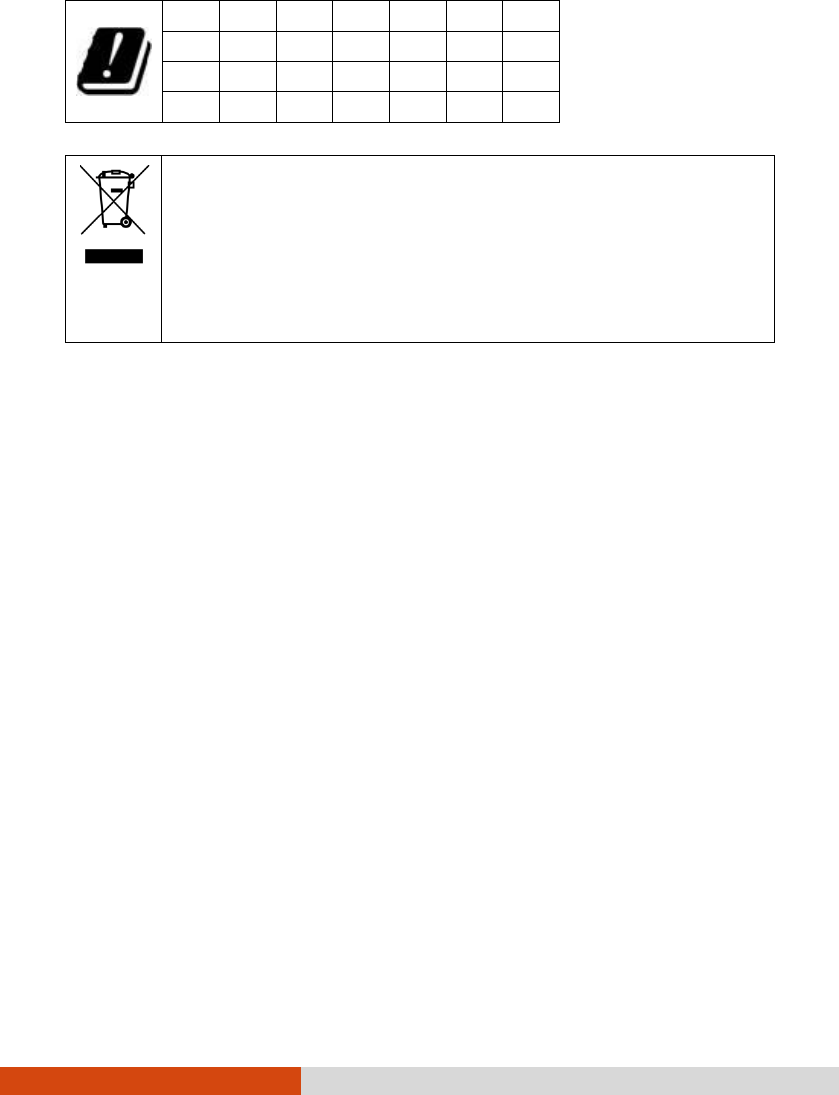
99
AT
BE
BG
HR
CY
CZ
DK
EE
FI
FR
DE
EL
HU
IE
IT
LV
LT
LU
MT
NL
PL
PT
RO
SK
SI
ES
SE
UK
Waste Electrical and Electronic Equipment (WEEE)
This symbol means that according to local laws and regulations your
product and/or its battery shall be disposed of separately from
household waste. When this product reaches its end of life, take it
to a collection point designated by local authorities. Proper recycling
of your product will protect human health and the environment.

100
User Notification of Take-back Service
To Institutional (B2B) Users in United States:
Getac believes in providing our institutional customers with easy-to-use solutions to
recycle your Getac-brand products for free. Getac understands the institutional
customers will likely be recycling multiple items at once and as such. Getac wants
to make the recycling process for these larger shipments as streamlined as possible.
Getac works with recycling vendors with the highest standards for protecting our
environment, ensuring worker safety, and complying with global environmental laws.
Our commitment to recycling our old equipment grows out of our work to protect
the environment in many ways.
Please see the product type below for information on Getac product, battery and
packaging recycling in USA.
For Product Recycling:
Your portable Getac products contain hazardous materials. While they pose no
risk to you during normal use, they should never be disposed with other wastes.
Getac provides a free take-back service for recycling your Getac products. Our
electronics recycler will provide competitive bids for recycling non-Getac products
as well.
For Battery Recycling:
The batteries used to power your portable Getac products contain hazardous
materials. While they pose no risk to you during normal use, they should never
be disposed with other wastes. Getac provides a free take-back service for
recycling your batteries from Getac products.
For Packaging Recycling:
Getac has chosen the packaging materials used to transport our products carefully,
to balance the requirements of shipping the product to you safely while minimizing
the amount of material used. The materials used in our packaging are designed
to be recycled locally.
If you have the above for recycling, please contact our recycler, All Green Electronics
Recycling, LLC. For more information on recycling, visit the website
http://www.allgreenrecycling.com.

101
ENERGY STAR 6.1
ENERGY STAR® is a government program that offers businesses and consumers
energy-efficient solutions, making it easy to save money while protecting the
environment for future generations.
Please reference ENERGY STAR® related information from
http://www.energystar.gov.
As an ENERGY STAR® Partner, Getac Technology Corporation has determined that
this product meets the ENERGY STAR® guidelines for energy efficiency.
An ENERGY STAR® qualified computer uses 70 % less electricity than computers without
enabled power management features.
Earning the ENERGY STAR®
When every home office is powered by equipment that has earned the ENERGY
STAR®, the change will keep over 289 billion pounds of greenhouse gases out
of the air.
If left inactive, ENERGY STAR® qualified computers enter a low-power mode
and may use 15 watts or less. New chip technologies make power management
features more reliable, dependable, and user-friendly than even just a few years
ago.
Spending a large portion of time in low-power mode not only saves energy,
but helps equipment run cooler and last longer.

102
Businesses that use ENERGY STAR® enabled office equipment may realize
additional savings on air conditioning and maintenance.
Over its lifetime, ENERGY STAR® qualified equipment in a single home office
(e.g., computer, monitor, printer, and fax) can save enough electricity to light
an entire home for more than 4 years.
Power management (“sleep settings”) on computers and monitors can result
in much savings annually.
Remember, saving energy prevents pollution
Because most computer equipment is left on 24 hours a day, power management
features are important for saving energy and are an easy way to reduce air pollution.
By using less energy, these products help lower consumers’ utility bills, and prevent
greenhouse gas emissions.
Getac Product Compliance
All Getac products with ENERGY STAR® logo comply with the ENERGY STAR®
standard, and the power management feature is enabled by default. As recommended
by the ENERGY STAR® program for optimal energy savings, the computer is
automatically set to sleep after 15 minutes (in battery mode) and 30 minutes (in
AC mode) of user inactivity. To wake up the computer, press the power button.
If you want to configure power management settings such as inactivity time and
ways to initiate/end Sleep mode, go to Power Options by right-clicking the battery
icon on the Windows taskbar and then selecting Power Options in the pop-up menu.
Please visit http://www.energystar.gov/powermanagement for detail information on
power management and its benefits to the environment.

103
Battery Recycling
For the U.S. and Canada only:
To recycle the battery, please go to the RBRC Call2Recycle website or use the
Call2Recycle Helpline at 800-822-8837.
Call2Recycle® is a product stewardship program providing no-cost battery and
cellphone recycling solutions across the U.S. and Canada. Operated by Call2Recycle,
Inc., a 501(c)4 nonprofit public service organization, the program is funded by
battery and product manufacturers committed to responsible recycling. See more at:
http://www.call2recycle.org

